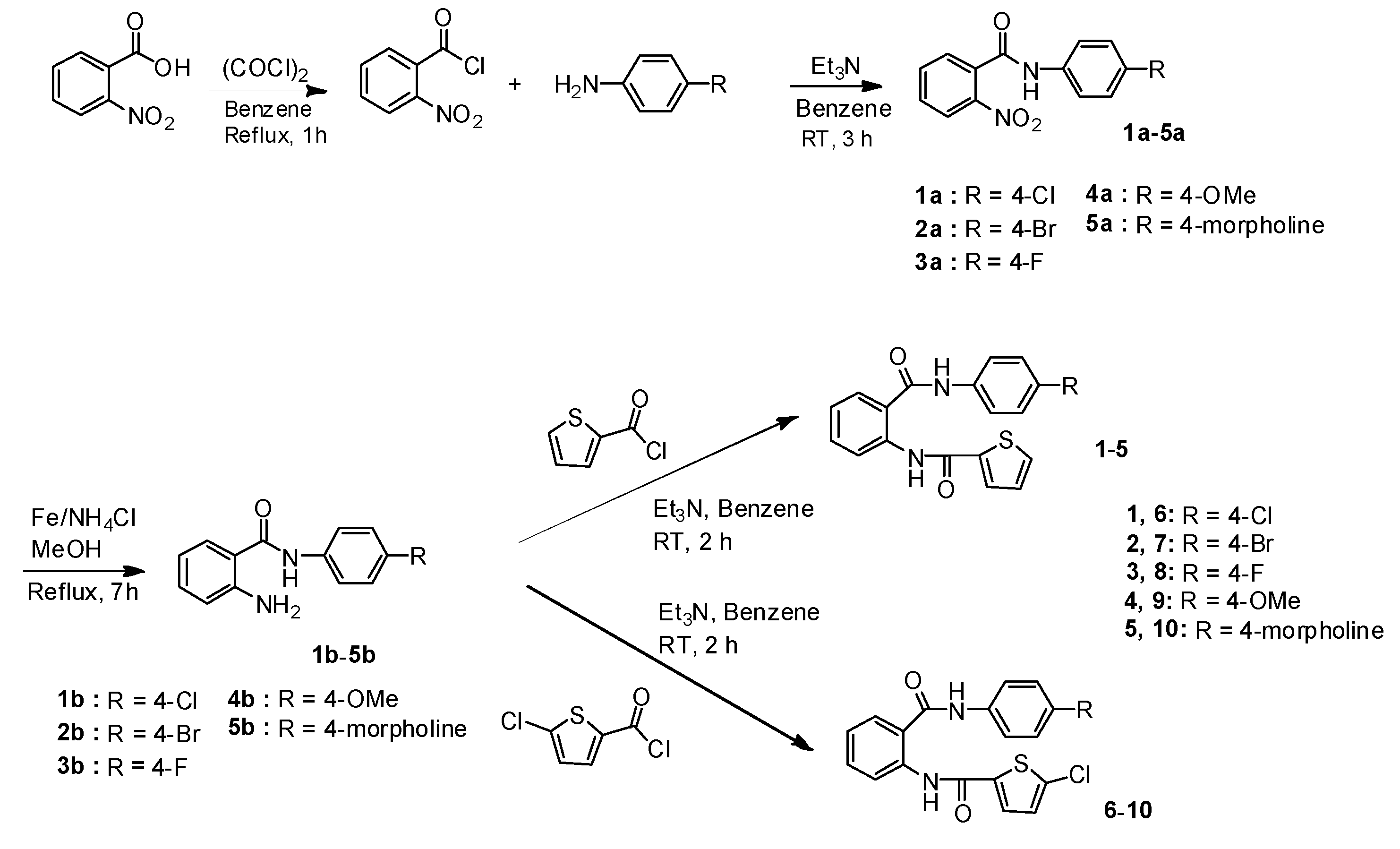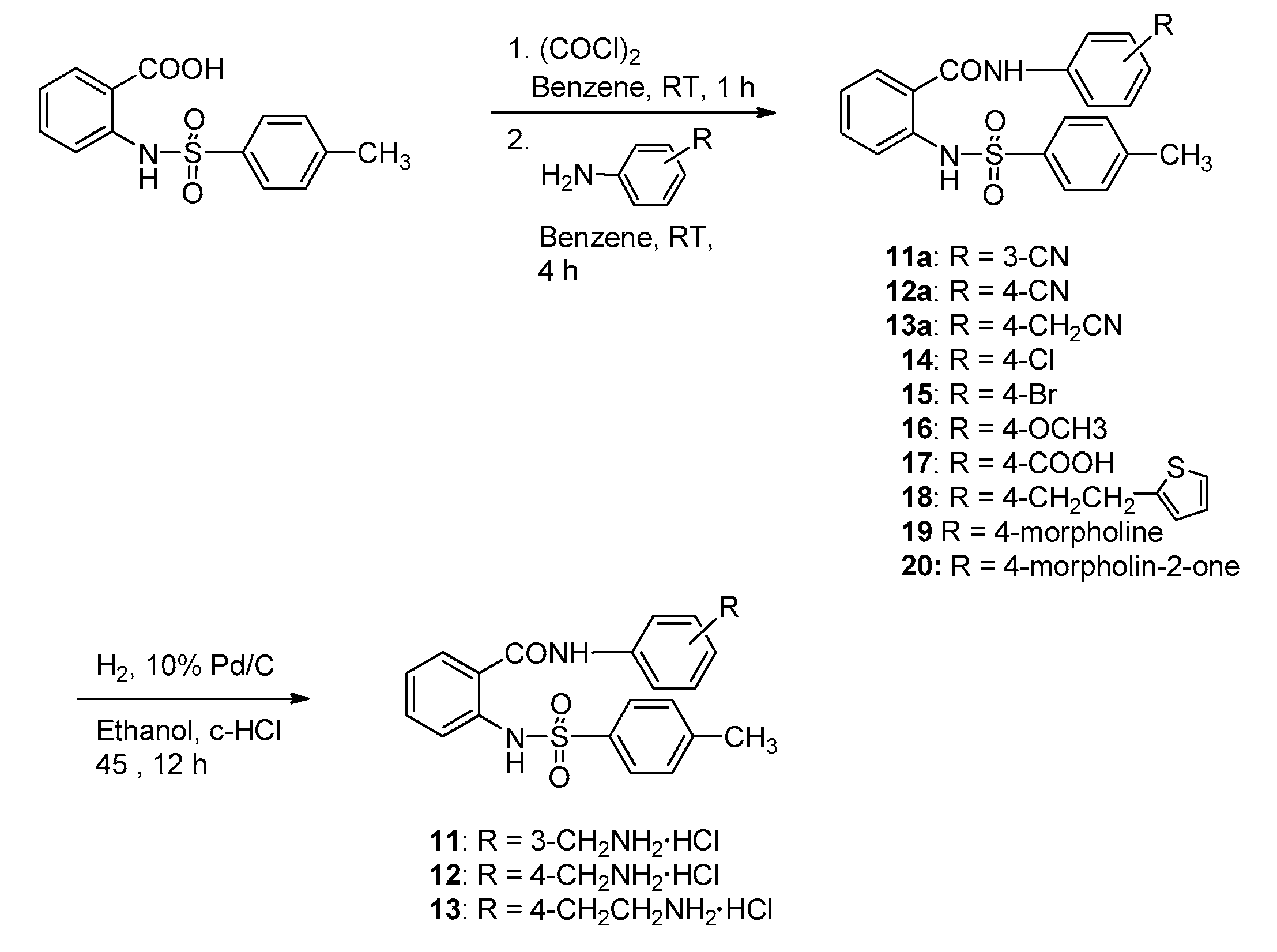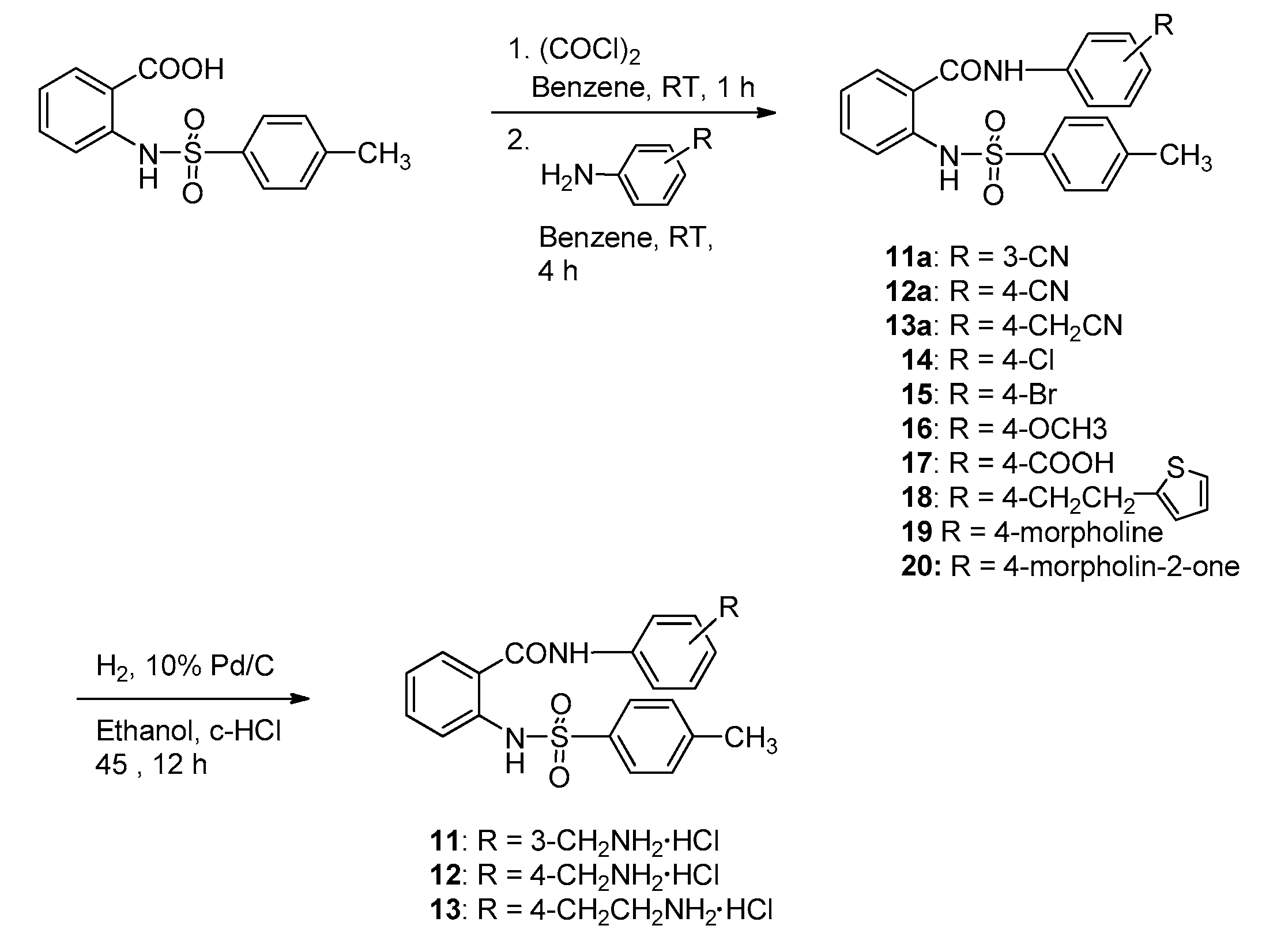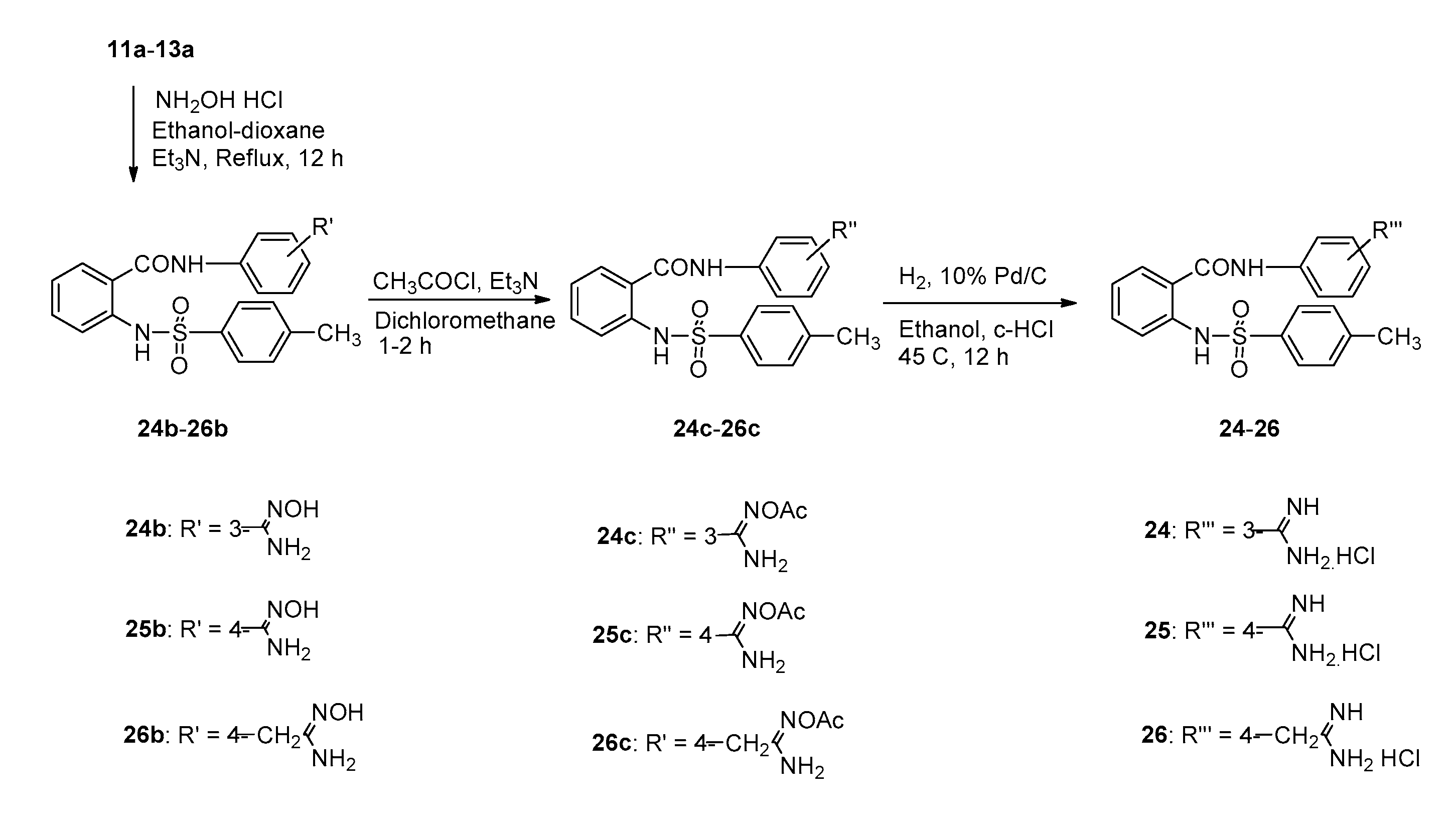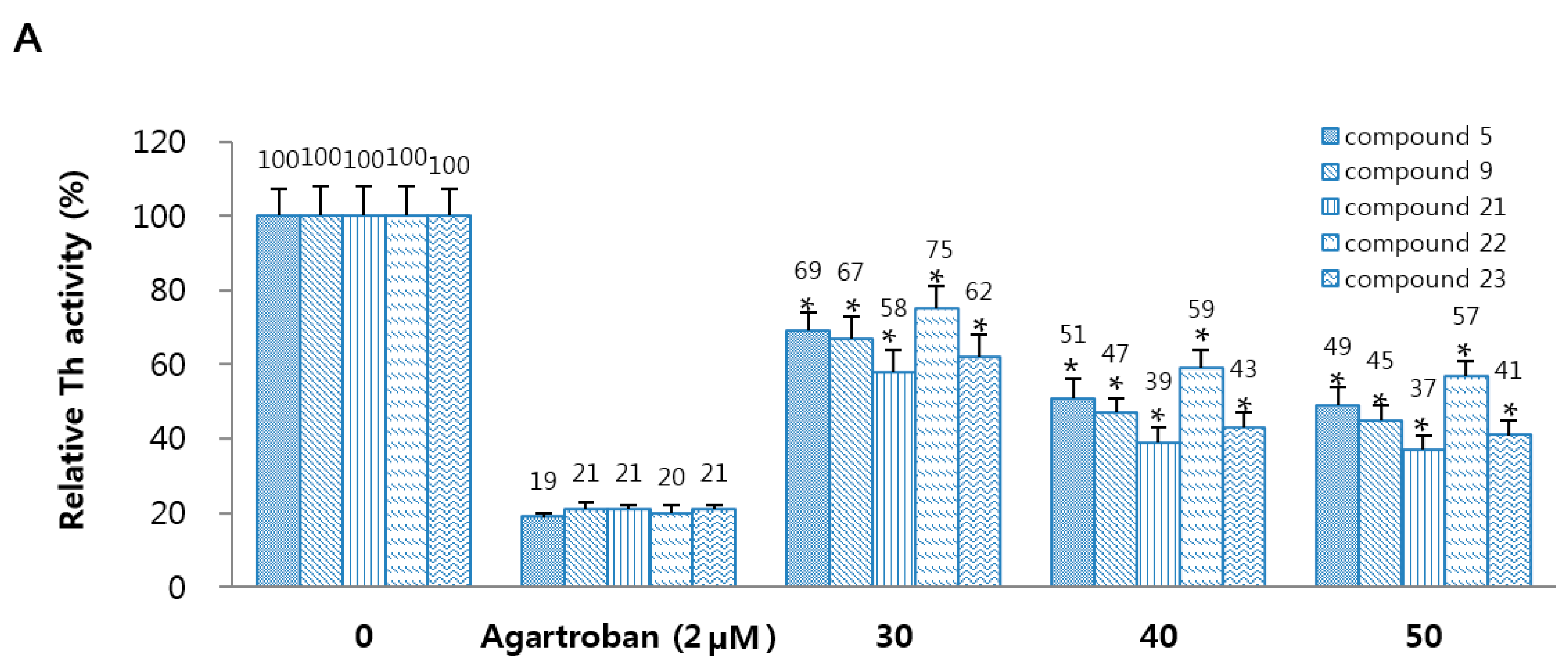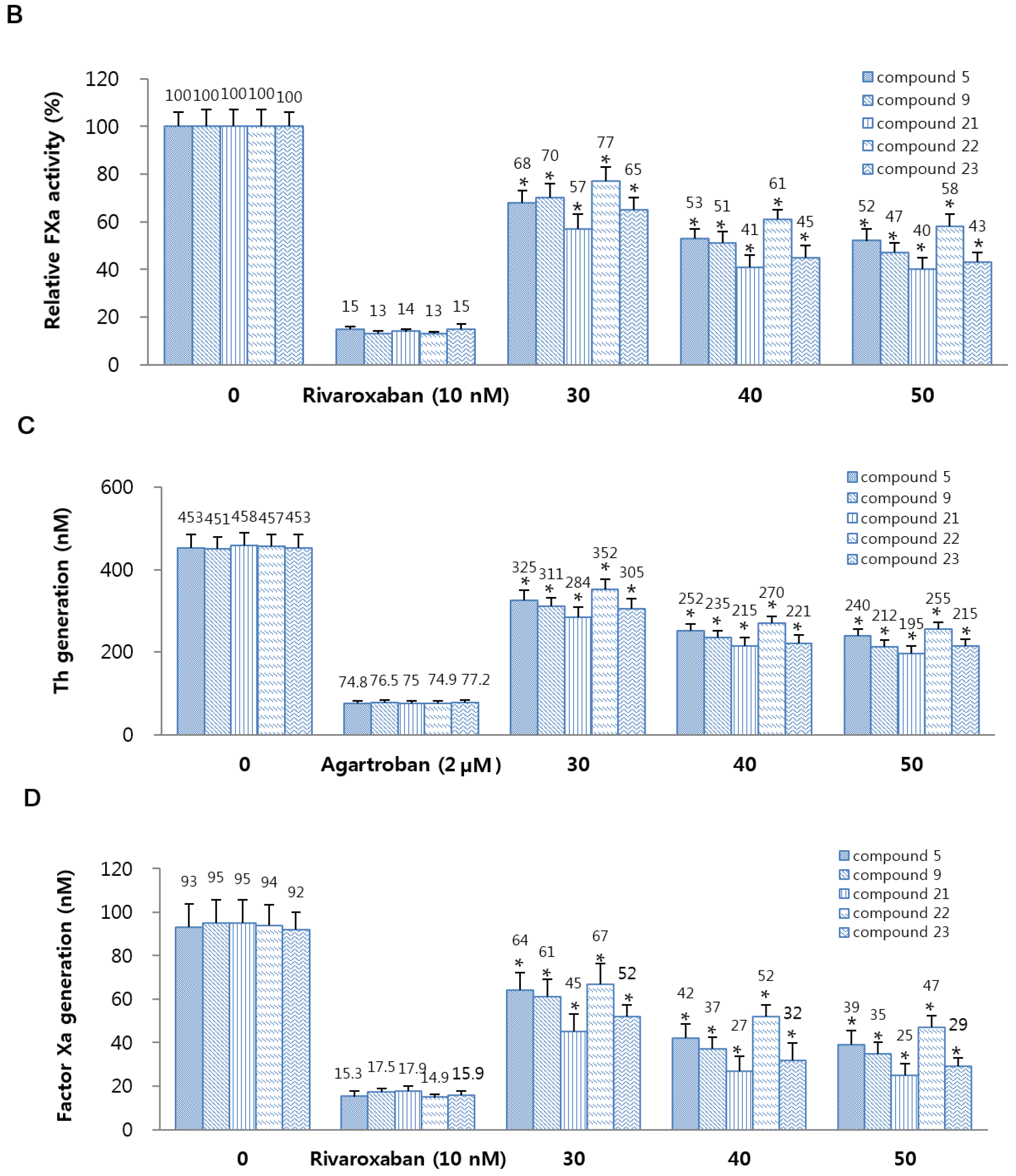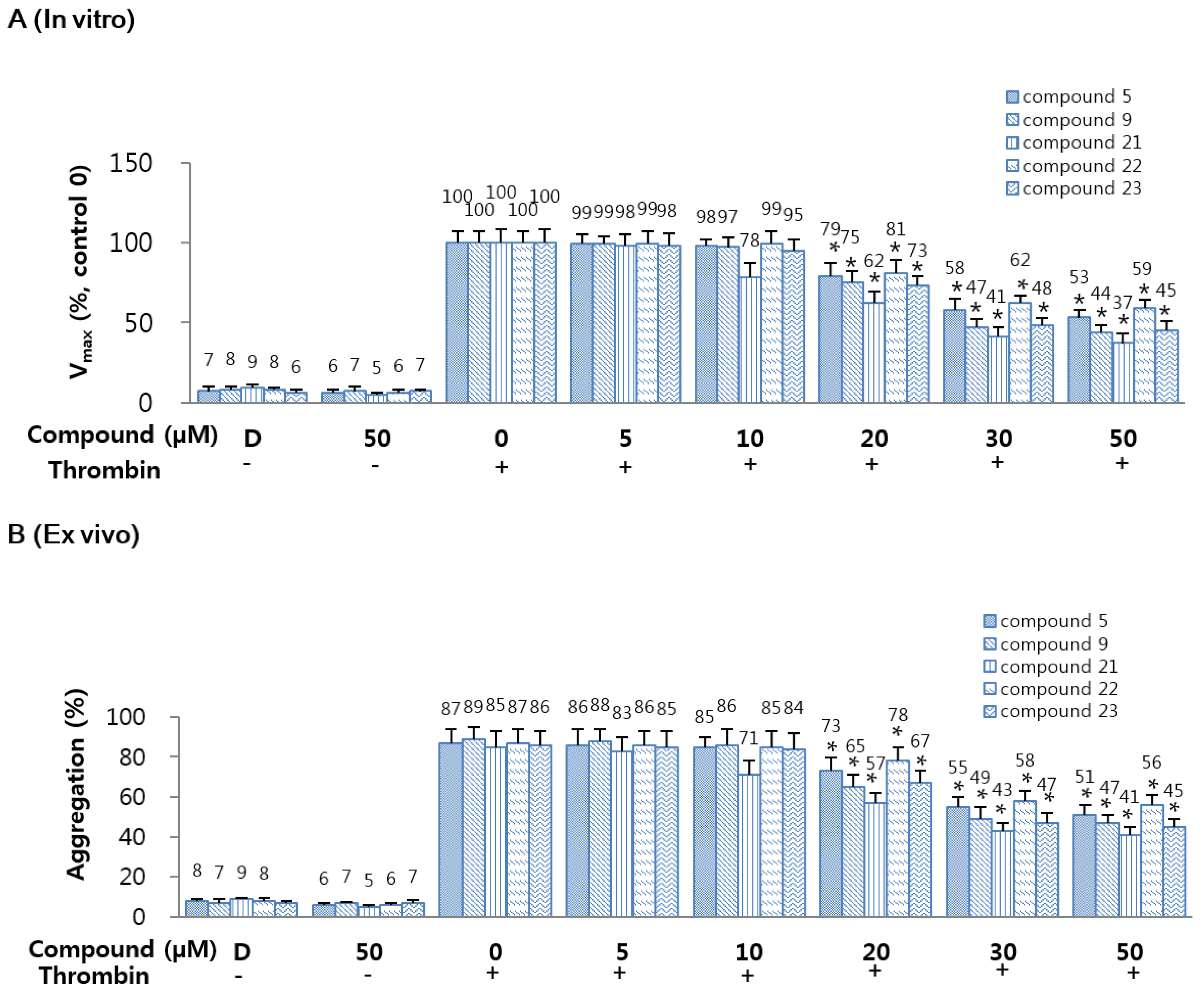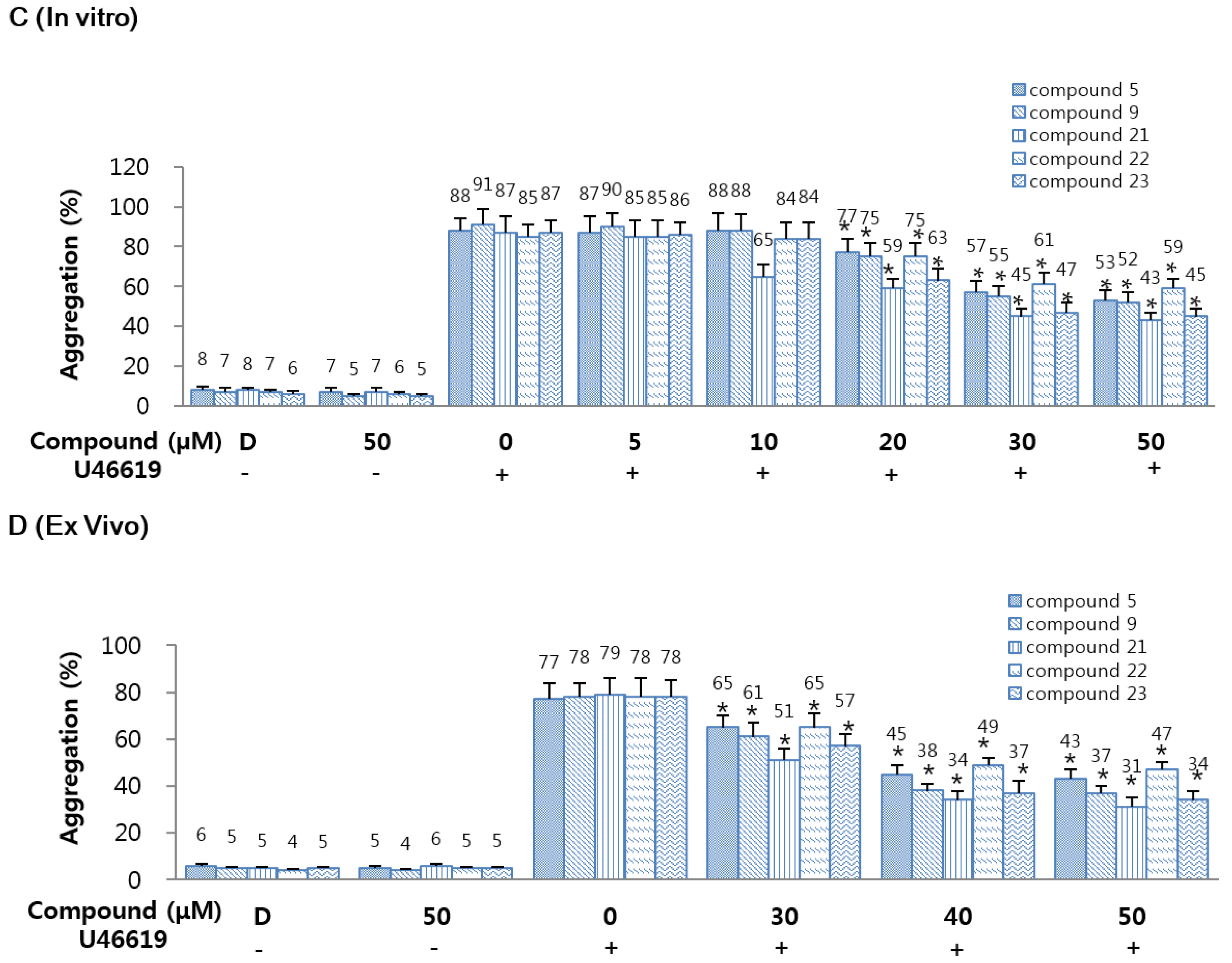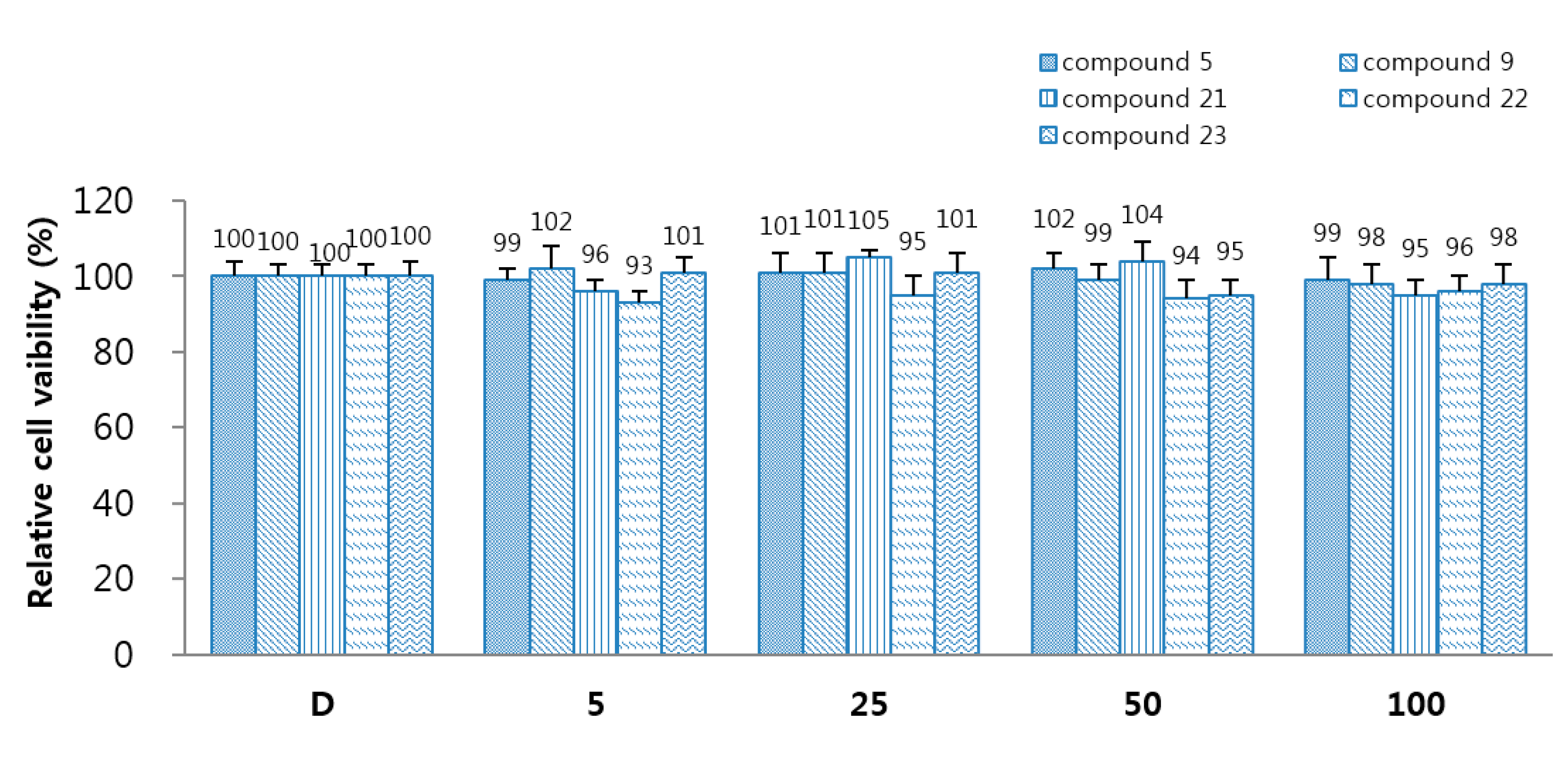3.1. Chemistry
3.1.1. Reagents and Instruments
The reagents were commercially purchased from Sigma-Aldrich (St. Louis, MO, USA) or TCI (Tokyo, Japan). If necessary, solvents were purified and/or dried prior to use. All anhydrous reactions were carried out under a dry atmosphere of nitrogen. Melting points (m.p.) were measured on Thomas-Hoover melting point apparatus (Thomas Scientific, Swedesboro, NJ, USA) and not corrected. 1H, 13C-NMR and HMBC spectra were measured on a Varian 400 MHz spectrometer (Agilent Technologies, Santa Clara, CA, USA) in DMSO-d6, CDCl3, or (CD3)2CO. Chemical shifts (δ) are in ppm relative to tetramethylsilane, and coupling constants (J) are in Hz. DIP-MS (EI) was measured on an Agilent 7890A-5975C GC/MSD (Agilent Technologies). GC/MS (EI) was determined on a SHIMADZU QP 2010 model (Shimadzu, Kyoto, Japan) and FAB-MS was determined on a JEOL JMS-700 Mstation (JEOL, Tokyo, Japan). Fraction collection was performed on an EYELA fraction collector DC-1500 (Tokyo Rikakikai, Tokyo, Japan). An analytical TLC was performed on pre-coated silica gel 60 F254 plates (Merck, Kenilworth, NJ, USA). Solvent systems for TLC and column chromatography were ethyl acetate/n-hexane mixtures and 10% methanol in dichloromethane. Column chromatography was carried out on Merck silica gel 9385 (Merck).
3.1.2. General Synthetic Procedures for 1a–5a
The oxalyl chloride (38.92 mmol) and triethylamine (32.93 mmol) were added to a solution of 2-nitrobenzoic acid (29.94 mmol) in anhydrous dichloromethane (50 mL) at room temperature. The reaction mixture was refluxed for 1 h and the unreacted oxalyl chloride and solvent were removed under reduced pressure and 2-nitrobenzoyl chloride was used to next reaction without purification. To a solution of 3-aminophenylcyanide or 4-aminophenylcyanide or 4-aminobenzyl cyanide (7.19 mmol) in anhydrous dichloromethane (30 mL) was added 2-nitrobenzoyl chloride (8.99 mmol) and triethylamine (7.19 mmol). The reaction mixture was stirred at room temperature for 3 h and added with water, extracted with dichloromethane (3 × 30 mL), dried with anhydrous magnesium sulfate and filtrated. The filtrate was concentrated under reduced pressure to afford the oily residue, which was separated by column chromatography to afford pure white or pale yellow compounds 1a–5a.
N-(4′-Chlorophenyl)-2-nitrobenzamide (
1a). Yield: 85%; m.p.: 184–186 °C (186–187 °C [
32]).
N-(4′-Bromophenyl)-2-nitrobenzamide (
2a) [
33,
34]. Yield: 86%; m.p.: 199–201 °C (202–205 °C [
35]).
N-(4′-Fluorophenyl)-2-nitrobenzamide (
3a). Yield: 78%; m.p.: 165–169 °C (167–171 °C [
36]).
N-(4′-Methoxyphenyl)-2-nitrobenzamide (
4a) [
37]. Yield: 82%; m.p.: 153–154 °C.
N-(4′-Morpholinophenyl)-2-nitrobenzamide (5a). Yield: 76%; m.p.: 220–221 °C; 1H NMR (400 MHz, DMSO-d6) δ: 3.03 (4H, t, J = 4.8 Hz, H3′′ + H5′′), 3.71 (4H, t, J = 4.8 Hz, H2′′ + H6′′), 6.91 (2H, d, J = 9.0 Hz, H3′ + H5′), 7.49 (2H, d, J = 9.0 Hz, H2′ + H6′), 7.68–7.71 (2H, m, H4 + H6), 7.82 (1H, dt, J = 8.0, 1.1 Hz, H5), 8.09 (1H, d, J = 7.6 Hz, H3), 10.42 (1H, s, CONH); 13C NMR (100 MHz, DMSO-d6) δ: 48.9 (C3′′, C5′′), 66.0 (C2′′, C6′′), 115.4 (C2′, C6′), 120.8 (C3′, C5′), 124.2 (C1), 129.3 (C3), 130.8 (C6), 131.0 (C1′), 132.8 (C4), 134.0 (C5), 146.6 (C2), 147.8 (C4′), 163.4 (C=O); GC-MS (EI) m/z: 327 [M]+.
3.1.3. General Synthetic Procedures for 1b–5b
Compounds 1a–5a (3.37 mmol) were dissolved in methanol (30 mL) and stirred with ammonium chloride (33.7 mmol) and iron powder (6.03 mmol) and then refluxed for 7 h. The reaction mixture was added with water and extracted with dichloromethane (3 × 40 mL), treated with anhydrous magnesium sulfate and filtrated. The filtrate was evaporated to prepare the oily residue, which was recrystallized with ethyl acetate and n-hexane mixture to afford pure white or pale yellow compounds 1b–5b.
2-Amino-
N-(4′-chlorophenyl)benzamide (
1b). Yield: 63%; m.p.: 148–150 °C (147 °C [
38]).
2-Amino-
N-(4′-bromophenyl)benzamide (
2b). Yield: 70%; m.p.: 143–145 °C (139–144 °C [
39]).
2-Amino
-N-(4′-fluorophenyl)benzamide (
3b). Yield: 62%; m.p.: 118–120 °C (122 °C [
38]).
2-Amino-
N-(4′-methoxyphenyl)benzamide [
38] (
4b). Yield: 80%; m.p.: 118–119 °C (121 °C [
38]).
2-Amino-N-(4′-morpholinophenyl)benzamide (5b). Yield: 97%; m.p.: 167–168 °C; 1H NMR (400 MHz, DMSO-d6 ) δ: 3.06 (4H, t, J = 4.8 Hz, H3′′ + H5′′), 3.74 (4H, t, J = 4.8 Hz, H2′′ + H6′′), 6.29 (2H, s, NH2), 6.57 (1H, dt, J = 7.7, 1.1 Hz, H5), 6.73 (1H, dd, J = 8.2, 1.0 Hz, H3), 6.91 (2H, d, J = 9.0 Hz, H3′ + H5′), 7.17 (1H, dt, J = 8.4, 1.5 Hz, H4), 7.56 (2H, d, J = 9.0 Hz, H2′ + H6′), 7.59 (1H, dd, J = 7.8, 1.8 Hz, H6), 9.80 (1H, s, CONH); 13C NMR (100 MHz, DMSO-d6) δ: 39.9 (C3′′, C5′′), 65.1 (C2′′, C6′′), 114.5 (C1), 115.2 (C2′, C6′), 115.6 (C3), 116.3 (C5), 121.7 (C3′, C5′), 129.5 (C6), 131.4 (C1′), 131.8 (C4), 147.4 (C4′), 149.6 (C2), 167.4 (C=O); GC-MS (EI) m/z: 297 [M]+.
3.1.4. General Synthetic Procedures for 1–10
Thiophene-2-carbonyl chloride and 5-chlorothiophene-2-carbonyl chloride were prepared according to the synthetic procedures for 1a–5a. Compounds 1b–5b (0.62 mmol) were dissolved in anhydrous benzene (30 mL) and then triethylamine (0.62 mmol) was slowly added and thiophene-2-carbonyl chloride (0.62 mmol) or 5-chlorothiophene-2-carbonyl chloride (0.62 mmol) was added. The reaction mixture was reacted at room temperature for 2 h and the following procedures were same as procedures for 1a–5a. Compounds 1–10 were recrystallized with ethyl acetate and n-hexane mixture to obtain as pure white or pale yellow compounds.
N-(4′-Chlorophenyl)-2-(thiophen-2′′-ylcarbonylamino)benzamide (1).Yield: 79%; m.p.: 197–199 °C; 1H NMR (400 MHz, DMSO-d6) δ: 7.25 (1H, dd, J = 4.9, 3.8 Hz, H4′′), 7.29 (1H, dt, J = 7.7, 1.1 Hz, H5), 7.43 (2H, d, J = 8.8 Hz, H3′ + H5′), 7.61 (1H, dt, J = 8.0, 1.2 Hz, H4), 7.74–7.78 (3H, m, H2′ + H6′ + H5′′), 7.88–8.02 (2H, m, H3 + H6), 8.32 (1H, d, J = 8.0 Hz, H3′′), 10.63 (1H, s, NHCO), 11.54 (1H, s, CONH); 13C NMR (100 MHz, DMSO-d6) δ: 121.6 (C3), 122.5 (C2′, C6′), 123.0 (C1), 123.4 (C5), 127.9 (C4′), 128.4 (C3′, C5′), 128.6 (C6), 128.8 (C4′′), 129.0 (C5′′), 132.2 (C4), 132.3 (C3′′), 137.5 (C2′′), 138.1 (C1′), 139.5 (C2), 159.4 (CONH), 167.3 (NHCO); DIP-MS (EI): m/z 356 [M]+; HRMS (FAB): m/z calcd for C18H14ClN2O2S [M + H]+ 357.0465, found 357.0478.
N-(4′-Bromophenyl)-2-((thiophen-2′′-yl)carbonylamino)benzamide (2). Yield: 75%; m.p.: 210–212 °C; 1H NMR (400 MHz, DMSO-d6) δ: 7.25 (1H, dd, J = 4.9, 3.8 Hz, H4′′), 7.30 (1H, dt, J = 7.8, 1.1 Hz, H5), 7.56 (2H, d, J = 8.9 Hz, H3′ + H5′), 7.61 (1H, dt, J = 8.0, 1.2 Hz, H4), 7.71 (2H, d, J = 8.9 Hz, H2′ + H6′), 7.75 (1H, dd, J = 3.7, 1.0 Hz, H5′′), 7.88–8.03 (2H, m, H3 + H6), 8.30 (1H, d, J = 8.2 Hz, H3′′), 10.64 (1H, s, NHCO), 11.51 (1H, s, CONH); 13C NMR (100 MHz, DMSO-d6) δ: 116.0 (C4′), 121.6 (C3), 122.9 (C2′, C6′), 123.1 (C1), 123.4 (C5), 128.4 (C6), 128.8 (C4′′), 129.0 (C5′′), 131.5 (C3′, C5′), 132.2 (C4), 132.3 (C3′′), 138.0 (C2′′), 138.1 (C1′), 139.5 (C2), 159.4 (CONH), 167.3 (NHCO); DIP-MS (EI): m/z 400 [M − 1]+, 402 [M + 1]+; HRMS (FAB): m/z calcd for C18H14BrN2O2S [M + H]+ 400.9959, found 400.9973.
N-(4′-Fluorophenyl)-2-((thiophen-2′′-yl)carbonylamino)benzamide (3). Yield: 73%; m.p.: 215–216 °C; 1H NMR (400 MHz, DMSO-d6) δ: 7.19–7.26 (3H, m, H3′ + H5′+ H4′′), 7.29 (1H, dt, J = 7.7, 1.1 Hz, H5), 7.61 (1H, dt, J = 8.0, 1.0 Hz, H4), 7.73–7.75 (3H, m, H2′ + H6′ + H5′′), 7.89 (1H, dd, J = 5.0, 1.1 Hz, H6), 7.92 (1H, dd, J = 7.8, 1.2 Hz, H3), 8.36 (1H, d, J = 7.6 Hz, H3′′), 10.58 (1H, s, NHCO), 11.68 (1H, s, CONH); 13C NMR (100 MHz, DMSO-d6) δ: 115.9 (J = 22.3 Hz, C3′, C5′), 122.0 (C3), 123.3 (C1), 123.7 (J = 8.2 Hz, C2′, C6′), 124.1 (C5), 129.1 (C6), 129.4 (C4′′), 129.6 (C5′′), 133.0 (C4, C3′′), 135.5 (J = 3.0 Hz, C1′), 139.0 (C2′′), 140.2 (C2), 159.4 (J = 239.4 Hz, C4′), 160.0 (CONH), 167.9 (NHCO); DIP-MS (EI): m/z 340 [M]+; HRMS (FAB): m/z calcd for C18H14FN2O2S [M + H]+ 341.0760, found 341.0781.
N-(4′-Methoxyphenyl)-2-(thiophen-2′′-ylcarbonylamino)benzamide (4). Yield: 77%; m.p.: 170–172 °C; 1H NMR (400 MHz, DMSO-d6) δ: 3.73 (3H, s, CH3), 6.96 (2H, d, J = 9.0 Hz, H3′ + H5′), 7.31–7.23 (2H, m, H5 + H4′′), 7.59–7.64 (3H, m, H4 + H2 + H6′), 7.73 (1H, dd, J = 3.7, 0.6 Hz, H5′′), 7.89 (1H, dd, J = 5.0, 0.6 Hz, H6), 7.94 (1H, d, J = 6.9 Hz, H3), 8.43 (1H, d, J = 8.2 Hz, H3′′), 10.45 (1H, s, NHCO), 11.92 (1H, s, CONH); 13C NMR (100 MHz, DMSO-d6) δ: 55.2 (CH3), 113.8 (C3′, C5′), 120.9 (C3), 122.1 (C1), 122.9 (C2′, C6′), 123.2 (C5), 128.4 (C6), 128.6 (C4′′), 128.8 (C5′′), 131.3 (C1′), 132.2 (C4), 132.3 (C3′′), 138.5 (C2′′), 139.6 (C2), 156.1 (C4′), 159.3 (CONH), 167.0 (NHCO); DIP-MS (EI): m/z 352 [M]+; HRMS (FAB): m/z calcd for C19H17N2O3S [M + H]+ 353.0960, found 353.0979.
N-(4′-Morpholinophenyl)-2-(thiophen-2′′′-ylcarbonylamino)benzamide (5). Yield: 76%; m.p.: 246–247 °C; 1H NMR (400 MHz, DMSO-d6) δ: 3.09 (4H, t, J = 4.8 Hz, H3′′ + H5′′), 3.74 (4H, t, J = 4.8 Hz, H2′′ + H6′′), 6.96 (2H, d, J = 9.0 Hz, H3′ + H5′), 7.22–7.30 (2H, m, H5 + H4′′′), 7.57–7.61 (3H, m, H4 + H2′ + H6′), 7.72 (1H, dd, J = 3.7, 0.6 Hz, H5′′′), 7.90 (1H, dd, J = 4.9, 0.5 Hz, H6), 7.93 (1H, d, J = 7.3 Hz, H3), 8.43 (1H, d, J = 8.1 Hz, H3′′′), 10.39 (1H, s, NHCO), 11.97 (1H, s, CONH); 13C NMR (100 MHz, DMSO-d6) δ: 48.7 (C3′′, C5′′), 66.1 (C2′′, C6′′), 115.2 (C3′, C5′), 120.8 (C3), 122.0 (C1), 122.4 (C2′,C6′), 123.1 (C5), 128.4 (C6), 128.6 (C4′′), 128.8 (C5′′), 130.3 (C1′), 132.2 (C4), 132.3 (C3′′), 138.6 (C2′′), 139.6 (C2), 148.1 (C4′), 159.3 (CONH), 166.9 (NHCO); DIP-MS (EI): m/z 407 [M]+; HRMS (FAB): m/z calcd for C22H22N3O3S [M + H]+ 408.1382, found 408.1368.
N-(4′-Chlorophenyl)-2-((5-chlorothiophen-2′′-yl)carbonylamino)benzamide (6). Yield: 60%; m.p.: 207–209 °C; 1H NMR (400 MHz, DMSO-d6) δ: 7.29 (1H, d, J = 4.0 Hz, H4′′), 7.32 (1H, dt, J = 7.7, 1.1 Hz, H5), 7.43 (2H, d, J = 8.9 Hz, H3′ + H5′), 7.60 (1H, dt, J = 8.0, 1.2 Hz, H4), 7.64 (1H, d, J = 4.1 Hz, H6), 7.75 (2H, d, J = 8.9 Hz, H2′ + H6′), 7.88 (1H, dd, J = 7.8, 1.0 Hz, H3), 8.17 (1H, d, J = 8.2 Hz, H3′′), 10.63 (1H, s, NHCO), 11.44 (1H, s, CONH); 13C NMR (100 MHz, DMSO-d6) δ: 122.2 (C3), 122.4 (C2′, C6′), 123.9 (C1), 124.2 (C5), 127.8 (C4′), 128.6 (C3′, C5′), 128.7 (C6), 129.1 (C4′′), 132.2 (C4, C3′′), 134.2 (C2′′), 137.4 (C5′′), 137.7 (C1′), 138.7 (C2), 158.4 (CONH), 167.1 (NHCO); DIP-MS (EI): m/z 390 [M − 1]+; HRMS (FAB): m/z calcd for C18H13Cl2N2O2S [M + H]+ 391.0075, found 391.0089.
N-(4′-Bromophenyl)-2-((5-chlorothiophen-2′′-yl)carbonylamino)benzamide (7). Yield: 41%; m.p.: 198–199 °C; 1H NMR (400 MHz, DMSO-d6) δ: 7.28 (1H, d, J = 4.1 Hz, H4′′), 7.32 (1H, dt, J = 7.7, 1.1 Hz, H5), 7.55 (2H, d, J = 8.9 Hz, H3′ + H5′), 7.60 (1H, dt, J = 8.0, 1.2 Hz, H4), 7.64 (1H, d, J = 4.1 Hz, H6), 7.70 (2H, d, J = 8.9 Hz, H2′ + H6′), 7.88 (1H, dd, J = 7.8, 1.3 Hz, H3), 8.18 (1H, dd, J = 8.2, 0.8 Hz, H3′′), 10.60 (1H, s, NHCO), 11.42 (1H, s, CONH); 13C NMR (100 MHz, DMSO-d6) δ: 115.9 (C4′), 122.1 (C3), 122.8 (C2′, C6′), 123.9 (C1), 124.2 (C5), 128.7 (C6), 129.0 (C4′′), 131.5 (C3′, C5′), 132.1 (C4, C3′′), 134.1 (C2′′), 137.4 (C5′′), 138.0 (C1′), 138.6 (C2), 158.4 (CONH), 167.1 (NHCO); DIP-MS (EI): m/z 434 [M − 1]+, 436 [M + 1]+; HRMS (FAB): m/z calcd for C18H13BrClN2O2S [M + H]+ 434.9570, found 434.9549.
N-(4′-Fluorophenyl)-2-((5-chlorothiophen-2′′-yl)carbonylamino)benzamide (8). Yield: 73%; m.p.: 215–216 °C; 1H NMR (400 MHz, DMSO-d6) δ: 7.22 (2H, t, J = 8.9 Hz, H3′ + H5′), 7.27–7.34 (2H, m, H5 + H4′′), 7.64–7.57 (2H, m, H4 + H6), 7.73 (2H, dd, J = 9.1, 5.1 Hz, H2′ + H6′), 7.91 (1H, dd, J = 7.9, 1.1 Hz, H3), 8.24 (1H, d, J = 8.1 Hz, H3′′), 10.57 (1H, s, NHCO), 11.60 (1H, s, CONH); 13C NMR (100 MHz, DMSO-d6) δ: 115.2 (J = 22.3 Hz, C2′, C6′), 121.8 (C3), 123.0 (J = 8.1 Hz, C3′, C5′), 123.5 (C1), 123.8 (C5), 128.6 (C6), 128.9 (C4′′), 132.2 (C4), 134.1 (C2′′), 134.8 (J = 2.2 Hz, C1′), 137.7 (C5′′), 138.6 (C2), 158.3 (CONH), 158.6 (J = 239.5 Hz, C4′), 167.0 (NHCO); DIP-MS (EI): m/z 374 [M]+; HRMS (FAB): m/z calcd for C18H13ClFN2O2S [M + H]+ 375.0370, found 375.0388.
N-(4′-Methoxyphenyl)-2-((5-chlorothiophen-2′′-yl)carbonylamino)benzamide (9). Yield: 77%; m.p.: 190–191 °C; 1H NMR (400 MHz, DMSO-d6) δ: 3.75 (3H, s, CH3), 6.95 (2H, d, J = 8.8 Hz, H3′ + H5′), 7.26–7.32 (2H, m, H5 + H4′′), 7.56–7.65 (4H, m, H4 + H6 + H2′ + H6′), 7.94 (1H, d, J = 7.7 Hz, H3), 8.31 (1H, d, J = 8.3 Hz, H3′′), 10.45 (1H, s, NHCO), 11.87 (1H, s, CONH); 13C NMR (100 MHz, DMSO-d6) δ: 55.4 (CH3), 114.0 (C2′, C6′), 121.6 (C3), 123.0 (C3′, C5′), 123.1 (C1), 123.8 (C5), 128.7 (C6), 128.8 (C4′′), 129.1 (C1′), 131.5 (C3′′), 132.3 (C4), 134.4 (C2′′), 138.2 (C5′′), 139.9 (C2), 156.3 (C4′), 158.5 (CONH), 167.1 (NHCO); DIP-MS (EI): m/z 386 [M]+; HRMS (FAB): m/z calcd for C19H16ClN2O3S [M + H]+ 387.0457, found 387.0470.
N-(4′-Morpholinophenyl)-2-((5-chlorothiophen-2′′′-yl)carbonylamino)benzamide (10). Yield: 80%; m.p.: 230–231 °C; 1H NMR (400 MHz, DMSO-d6) δ: 3.08 (4H, t, J = 4.8 Hz, H3′′ + H5′′), 3.74 (4H, t, J = 4.8 Hz, H2′′ + H6′′), 6.96 (2H, d, J = 9.1 Hz, H3′ + H5′), 7.23–7.32 (2H, m, H5 + H4′′′), 7.51–7.64 (4H, m, H4 + H6 + H2′ + H6′), 7.92 (1H, dd, J = 7.9, 1.1 Hz, H3), 8.32 (1H, d, J = 8.3 Hz, H3′′′), 10.39 (1H, s, NHCO); 13C NMR (100 MHz, DMSO-d6) δ: 51.6 (C3′′, C5′′), 68.9 (C2′′, C6′′), 118.0 (C3′, C5′), 124.1 (C3), 125.2 (C2′, C6′), 125.6 (C1), 126.4 (C5), 131.2 (C6), 131.5 (C4′′), 131.7 (C3′′), 133.2 (C4), 135.0 (C2′′), 137.0 (C1′), 140.9 (C5′′), 141.6 (C2), 150.9 (C4′), 161.1 (CONH), 169.6 (NHCO); DIP-MS (EI): m/z 441[M]+; HRMS (FAB): m/z calcd for C22H21ClN3O3S [M + H]+ 442.0992, found 442.0977.
3.1.5. General Synthetic Procedures for 11a–13a
To a solution of 4-(methylphenylsulfonamido)benzoyl chloride (2, 2.06 mmol) in anhydrous benzene (30 mL) was added 3- or 4-aminobenzonitrile (220 mg, 1.87 mmol), 4-aminobenzylcyanide (265 mg, 1.87 mmol) and triethylamine (0.1 mL). The following procedures were same as procedures for 1a–5a. Compounds 11a–13a were recrystallized with dichloromethane and n-hexane mixture to obtain as a white powder.
N-(3’-Cyanophenyl)-2-(4”-methylphenylsulfonamido)benzamide (11a). Yield: 75%; m.p.: 216–218 °C; 1H NMR (400 MHz, DMSO-d6) δ: 2.23 (3H, s, CH3), 7.21 (2H, d, J = 8.4 Hz, H3′′ + H5′′), 7.23 (1H, t, J = 7.6 Hz, H5), 7.36 (1H, d, J = 8.0 Hz, H3), 7.48 (1H, t, J = 7.6 Hz, H4), 7.54–7.65 (4H, m, H6 + H5′ + H2′′ + H6′′), 7.69 (1H, d, J = 7.2 Hz, H4′), 7.88 (1H, d, J = 7.6 Hz, H6′), 8.08 (1H, s, H2′), 10.26 (1H, s, NHSO2), 10.53 (1H, s, CONH); 13C NMR (100 MHz, DMSO-d6) δ: 21.6 (CH3), 112.1 (C3′), 119.3 (CN), 122.9 (C3), 124.1 (C1), 125.9 (C5), 127.6 (C6), 127.8 (C6′), 128.3 (C2′′, C6′′), 129.8 (C5′), 130.4 (C3′′, C5′′), 130.8 (C2′), 133.1 (C4), 136.6 (C4′), 137.1 (C1′′), 137.4 (C4′′), 140.0 (C1′), 144.3 (C2), 167.5 (C=O); DIP-MS (EI): m/z 391 [M]+.
N-(4′-Cyanophenyl)-2-(4”-methylphenylsulfonamido)benzamide (12a). Yield: 70%; m.p.: 253–255 °C; 1H NMR (400 MHz, DMSO-d6) δ: 2.22 (3H, s, CH3), 7.12–7.26 (3H, m, H5 + H3′′ + H5′′), 7.33 (1H, d, J = 7.6 Hz, H3), 7.47 (1H, t, J = 7.6 Hz, H4), 7.56 (2H, d, J = 7.6 Hz, H2′′ + H6′′), 7.67 (1H, d, J = 7.2 Hz, H6), 7.77–7.87 (4H, m, H2′ + H3′ + H5′ + H6′), 10.16 (1H, s, NHSO2), 10.59 (1H, s, CONH); 13C NMR (100 MHz, DMSO-d6) δ: 21.6 (CH3), 106.4 (C4′), 119.7 (CN), 121.2 (C2′, C6′), 123.1 (C3), 125.2 (C1), 126.4 (C5), 127.5 (C6), 128.0 (C2′′, C6′′), 130.4 (C3′′, C5′′), 133.1 (C3′, C5′), 133.8 (C4), 137.2 (C1′′, C4′′), 143.6 (C1′), 144.3 (C2), 167.6 (C=O); DIP-MS (EI): m/z 391 [M]+.
N-(4′-Cyanomethylphenyl)-2-(4”-methylphenylsulfonamido)benzamide (13a). Yield: 68%; m.p.: 142–146 °C; 1H NMR (400 MHz, DMSO-d6) δ: 2.27 (3H, s, CH3), 4.02 (2H, s, CH2), 7.20–7.29 (3H, m, H5 + H3′′ + H5′′), 7.36 (2H, d, J = 8.8 Hz, H3′ + H5′), 7.45–7.53 (2H, m, H3 + H4), 7.67 (2H, d, J = 8.4 Hz, H2′′ + H6′′), 7.76 (1H, dd, J = 8.0, 1.2 Hz, H6), 10.39 (1H, s, NHSO2), 10.59 (1H, s, CONH); 13C NMR (100 MHz, DMSO-d6) δ: 21.0 (CH3), 21.9 (CH2), 119.3 (CN), 121.4 (C2′, C6′), 124.0 (C3), 124.1 (C1), 126.8 (C5), 127.0 (C6), 128.4 (C2′′, C6′′), 129.1 (C3′, C5′), 129.8 (C3′′, C5′′), 132.4 (C4), 135.9 (C1′), 137.2 (C1′′), 137.7 (C4′′), 143.7 (C2), 166.7 (C=O); GC-MS (EI) m/z: 405 [M]+.
3.1.6. General Synthetic Procedures for 11–13
To a suspension of 10% Pd-C (200 mg) in ethanol (50 mL) was added 1N-HCl (1 mL) and nitriles 11a–13a (1.28 mmol) and the reaction mixture was catalytically hydrogenated in parr hydrogenation apparatus (50 psi of hydrogen) at room temperature for 6 h. When the starting material could be no longer detected by TLC, the reaction mixture was filtrated on celite pad. The filtrate was concentrated to give the oily product which was diluted in ethanol and then crystallized with diethyl ether to form the light brown precipitate which was recrystallized with ethanol and diethyl ether mixture to afford 11–13 as a white powder.
N-(3’-Aminomethyl)phenyl-2-(4”-methylphenylsulfonamido)benzamide (11). Yield: 72%; m.p: 163–166 °C; 1H NMR (400 MHz, CD3OD) δ: 2.29 (3H, s, CH3), 4.03 (2H, s, CH2), 7.23 (1H, t, J = 7.2 Hz, H4), 7.27 (2H, d, J = 8.4 Hz, H3′′ + H5′′), 7.32 (1H, d, J = 7.6 Hz, H4′), 7.40–7.45 (2H, m, H5′ + H6′), 7.42 (1H, t, J = 7.6 Hz, H5), 7.55 (1H, d, J = 8.4 Hz, H3), 7.63 (2H, d, J = 8.4 Hz, H2′′ + H6′′), 7.83 (1H, d, J = 7.6 Hz, H6), 7.90 (1H, s, H2′), 8.50 (3H, br s, aminium chloride), 10.52 (1H, s, NHSO2), 10.69 (1H, s, CONH); 13C NMR (100 MHz, DMSO-d6) δ: 20.9 (CH3), 42.3 (CH2), 121.0 (C2′), 121.2 (C6′), 121.5 (C3), 123.6 (C1), 124.8 (C5), 126.8 (C2′′, C6′′), 128.9 (C6), 129.2 (C4′), 129.8 (C3′′, C5′′), 132.5 (C4, C1′), 134.5 (C3′), 137.4 (C1′′), 138.5 (C4′′), 143.7 (C2), 166.8 (C=O); DIP-MS (EI): m/z 395 [M − HCl]+; HRMS (FAB): calcd for C21H22N3O3S [M + H]+ 396.1382, found 396.1396.
N-(4′-Aminomethyl)phenyl-2-(4”-methylphenylsulfonamido)benzamide (12). Yield: 81%; m.p: 92–95 °C; 1H NMR (400 MHz, CD3OD) δ: 2.29 (3H, s, CH3), 4.03 (2H, s, CH2), 7.18–7.24 (3H, m, H4 + H3′′ + H5′′), 7.42 (1H, t, J = 8.0 Hz, H5), 7.45–7.53 (3H, m, H3 + H3′+ H5′), 7.61 (2H, d, J = 8.4 Hz, H2′′ + H6′′), 7.69 (2H, d, J = 8.4 Hz, H2′ + H6′), 7.80 (1H, d, J = 8.0 Hz, H6), 8.36 (3H, br s, aminium chloride), 10.44 (1H, s, NHSO2), 10.61 (1H, s, CONH); 13C NMR (100 MHz, DMSO-d6) δ: 20.9 (CH3), 41.8 (CH2), 120.9 (C2′, C6′), 121.4 (C3), 124.0 (C1), 124.1 (C5), 126.8 (C2′′, C6′′), 129.1 (C6), 129.3 (C3′, C5′), 129.8 (C3′′, C5′′), 132.4 (C4, C1′), 135.9 (C4′), 137.2 (C1′′), 138.4 (C4′′), 143.7 (C2), 166.7 (C=O); DIP-MS (EI): m/z 395 [M − HCl]+; HRMS (FAB): calcd for C21H22N3O3S [M]+ 396.1382, found 396.1399.
N-(4′-Aminoethyl)phenyl-2-(4”-methylphenylsulfonamido)benzamide (13). Yield: 77%; m.p: 253–255 °C; 1H NMR (400 MHz, CD3OD) δ: 2.27 (3H, s, CH3), 2.98 (2H, t, J = 7.8 Hz, CH2), 3.21 (2H, t, J = 7.8 Hz, CH2), 7.14 (2H, m, H3′ + H5′), 7.23 (1H, t, J = 7.6 Hz, H4), 7.30 (2H, d, J = 8.0 Hz, H3′′ + H5′′), 7.46–7.61 (6H, m, H3 + H5 + H2′ + H6′ + H2′′ + H6′′), 7.67 (1H, d, J = 7.6 Hz, H6), 8.33 (3H, br s, aminium chloride), 10.41 (1H, s, NHSO2), 10.63 (1H, s, CONH); 13C NMR (100 MHz, DMSO-d6) δ: 20.2 (CH3), 32.9 (CH2), 40.7 (CH2), 121.8 (C2′, C6′), 123.5 (C3), 124.8 (C1), 125.3 (C5), 127.1 (C2′′, C6′′), 128.2 (C6), 129.0 (C3′, C5′), 129.5 (C3′′, C5′′), 132.2 (C4), 133.2 (C4′), 136.1 (C1′), 137.3 (C1′′), 137.7 (C4′′), 144.1 (C2), 167.7 (C=O); DIP-MS (EI): m/z 409 [M − HCl]+; HRMS (FAB): calcd for C22H24N3O3S [M + H]+ 410.1538, found 410.1520.
3.1.7. General Synthetic Procedures for 14–20
To a solution of 4-(methylphenylsulfonamido)benzoyl chloride (2, 1.50 mmol) was dissolved in anhydrous benzene (30 mL) was added 4-chloroaniline or 4-bromoaniline or 4-methoxyaniline or 4-carboxyaniline or 2-(thiophen-2-yl)ethylamine or 4-morpholinoaniline or 4-(2-oxomorpholino)aniline (1.36 mmol) and triethylamine (0.1 mL). The following procedures were same as procedures for 1a–5a. Compounds 14–20 were recrystallized with dichloromethane and n-hexane mixture to afford a white powder, respectively.
N-(4′-Chlorophenyl)-2-(4"-methylphenylsulfonamido)benzamide (14). Yield: 82%; m.p: 220–223 °C; 1H NMR (400 MHz, DMSO-d6) δ: 2.29 (3H, s, CH3), 7.20–7.30 (3H, m, H4 + H3′′ + H5′′), 7.58 (2H, d, J = 7.6 Hz, H3′ + H5′), 7.69 (2H, d, J = 8.0 Hz, H2′′ + H6′′), 7.71 (2H, d, J = 7.6 Hz, H2′ + H6′), 7.98 (1H, t, J = 7.6 Hz, H5), 8.03 (1H, d, J = 8.0 Hz, H3), 8.18 (1H, d, J = 8.0 Hz, H6) 11.95 (1H, s, CONH); 13C NMR (100 MHz, DMSO-d6) δ: 21.6 (CH3), 121.2 (C2′, C6′), 123.1 (C3), 125.2 (C1), 126.4 (C5), 127.5 (C6), 128.0 (C2′′, C6′′), 129.9 (C4′), 130.4 (C3′′, C5′′), 133.1 (C4, C3′, C5′), 136.8 (C1′′), 137.2 (C4′′), 144.3 (C2), 167.6 (C=O); DIP-MS (EI) m/z: 400 [M]+; HRMS (FAB): calcd for C20H18ClN2O3S [M + H]+ 401.0727, found 401.0741.
N-(4′-Bromophenyl)-2-(4"-methylphenylsulfonamido)benzamide (15). Yield: 80%; m.p: 211–213 °C; 1H NMR (400 MHz, CDCl3) δ: 2.26 (3H, s, CH3), 7.12–7.21 (3H, m, H4 + H3′′ + H5′′), 7.38 (2H, d, J = 8.8 Hz, H3′ + H5′), 7.43–7.51 (4H, m, H3 + H5 + H2′ + H6′), 7.62 (2H, d, J = 8.4 Hz, H2′′ + H6′′), 7.69 (1H, d, J = 7.8 Hz, H6) 10.1 (1H, s, NHSO2), 10.45 (1H, s, CONH); 13C NMR (100 MHz, CDCl3) δ: 21.7 (CH3), 118.2 (C4′), 122.2 (C2′, C6′), 122.7 (C3), 122.9 (C1), 124.3 (C5), 126.9 (C6), 127.5 (C2′′, C6′′), 129.8 (C3′′, C5′′), 132.3 (C3′, C5′), 133.3 (C4), 136.4 (C1′), 136.5 (C1′′), 138.8 (C4′′), 144.0 (C2), 166.7 (C=O); DIP-MS (EI) m/z: 444 [M]+; HRMS (FAB): calcd for C20H18BrN2O3S [M + H]+ 445.0222, found 445.0239.
N-(4′-Methoxyphenyl)-2-(4"-methylphenylsulfonamido)benzamide (16). Yield: 87%; m.p: 157–159 °C; 1H NMR (400 MHz, CDCl3) δ: 2.28 (3H, s, CH3), 3.76 (3H, s, OCH3), 6.95 (2H, d, J = 8.8 Hz, H3′ + H5′), 7.21 (1H, t, J = 6.8 Hz, H4), 7.26 (2H, d, J = 8.0 Hz, H3′′ + H5′′), 7.44–7.50 (2H, m, H3 + H5), 7.54 (2H, d, J = 8.8 Hz, H2′+ H6′), 7.61 (2H, d, J = 8.4 Hz, H2′′ + H6′′), 7.77 (1H, d, J = 7.6 Hz, H6), 10.23 (1H, s, NHSO2), 10.81 (1H, s, CONH); 13C NMR (100 MHz, CDCl3) δ: 21.6 (CH3), 55.9 (OCH3), 114.4 (C3′, C5′), 121.6 (C3), 123.4 (C2′, C6′), 124.0 (C1), 124.6 (C5), 127.5 (C2′′, C6′′), 129.6 (C6), 130.5 (C3′′, C5′′), 131.8 (C1′), 133.0 (C4), 136.5 (C1′′), 138.2 (C4′′), 144.4 (C2), 156.8 (C4′), 167.0 (C=O) DIP-MS (EI) m/z: 396 [M]+; HRMS (FAB): calcd for C21H21N2O4S [M + H]+ 397.1222, found 397.1241.
N-(4′-Carboxyphenyl)-2-(4"-methylphenylsulfonamido)benzamide (17). Yield: 85%; m.p: 210–212 °C; 1H NMR (400 MHz, DMSO-d6) δ: 2.23 (3H, s, CH3), 7.18–7.25 (3H, m, H4 + H3′′ + H5′′), 7.36 (1H, d, J = 8.4 Hz, H3), 7.47 (1H, t, J = 7.6 Hz, H5), 7.57 (2H, d, J = 8.0 Hz, H2′′ + H6′′), 7.61 (2H, d, J = 8.8 Hz, H2′ + H6′), 7.86 (2H, d, J = 8.8 Hz, H3′ + H5′), 7.71 (1H, d, J = 8.0 Hz, H6), 10.31 (1H, s, NHSO2), 10.52 (1H, s, CONH); 13C NMR (100 MHz, DMSO-d6) δ: 21.3 (CH3), 117.5 (C2′, C6′), 122.0 (C3), 124.3 (C1), 124.3 (C5), 126.8 (C4′), 127.1 (C2′′, C6′′), 129.0 (C6), 128.9 (C3′′, C5′′), 130.8 (C3′, C5′), 132.8 (C4), 136.1 (C1′′), 138.5 (C4′′), 144.1 (C2), 167.3 (C=O) DIP-MS (EI) m/z: 410 [M]+; HRMS (FAB): calcd for C21H19N2O5S [M + H]+ 411.1015, found 411.1036.
N-(2-(thiophen-2′-yl)ethyl)-2-(4"-methylphenylsulfonamido)benzamide (18). Yield: 60%; m.p: 119–121 °C; 1H NMR (400 MHz, CDCl3) δ: 2.31 (3H, s, CH3), 3.02 (2H, t, J = 6.8 Hz, CH2), 3.45 (2H, q, J = 6.8 Hz, CH2), 6.91 (1H, d, J = 2.4 Hz, H3′), 6.96 (1H, d, J = 5.2, 3.6 Hz, H4′), 7.13 (1H, t, J = 7.2 Hz, H4), 7.31 (2H, d, J = 8.0 Hz, H3′′ + H5′′), 7.35 (1H, dd, J = 5.2, 1,2 Hz, H5′), 7.42–7.53 (2H, m, H3 + H5), 7.61 (2H, d, J = 8.4 Hz, H2′′ + H6′′), 7.66 (1H, d, J = 8.0 Hz, H6), 8.91 (1H, s, NHSO2), 11.57 (1H, s, CONH); 13C NMR (100 MHz, CDCl3) δ: 21.0 (CH3), 28.7 (CH2), 40.9 (CH2), 119.7 (C3), 120.6 (C1), 123.4 (C5), 124.2 (C5′), 125.3 (C4′), 126.8 (C2′′, C6′′), 127.0 (C3′), 128.3 (C6), 129.9 (C3′′, C5′′), 132.4 (C4), 135.9 (C1′′), 138.4 (C4′′), 141.2 (C2′), 143.8 (C2), 168.0 (C=O); DIP-MS (EI) m/z: 400 [M]+; HRMS (FAB): calcd for C20H21N2O3S2 [M + H]+ 401.0994, found 401.0982.
N-(4′-morpholinophenyl)-2-(4"-methylphenylsulfonamido)benzamide (19). Yield: 55%; m.p: 206–209 °C; 1H NMR (400 MHz, CDCl3) δ: 2.29 (3H, s, CH3), 3.09 (4H, t, J = 4.8 Hz, CH2), 3.75 (4H, t, J = 4.4 Hz, CH2), 6.95 (2H, d, J = 8.8 Hz, H3′ + H5′), 7.20 (1H, t, J = 6.0 Hz, H4), 7.26 (2H, d, J = 8.4 Hz, H3′′ + H5′′), 7.45–7.53 (4H, m H3 + H5 + H2′ + H6′), 7.61 (2H, d, J = 8.4 Hz, H2′′ + H6′′), 7.77 (1H, d, J = 7.6 Hz, H6), 10.18 (1H, s, NHSO2), 10.89 (1H, s, CONH); 13C NMR (100 MHz, CDCl3) δ: 21.7 (CH3), 49.4 (2 x CH2), 66.8 (2 x CH2), 115.8 (C3′, C5′), 122.9 (C3), 123.9 (C1, C2′, C6′), 124.6 (C5), 127.6 (C2′′, C6′′), 129.6 (C6), 130.5 (C3′′, C5′′), 130.7 (C1′), 133.0 (C4), 136.5 (C1′′), 138.2 (C4′′), 144.4 (C2), 148.8 (C4′), 166.9 (C=O); DIP-MS (EI) m/z: 451 [M]+; HRMS (FAB): calcd for C24H26N3O4S [M + H]+ 452.1644, found 452.1627.
N-(4′-(2-oxomorpholino)phenyl)-2-(4"-methylphenylsulfonamido)benzamide (20). Yield: 44%; m.p: 270–273 °C; 1H NMR (400 MHz, CDCl3) δ: 2.28 (3H, s, CH3), 3.74 (2H, t, J = 4.8 Hz, CH2), 3.99 (2H, t, J = 4.8 Hz, CH2), 4.21 (2H, s, CH2), 7.20–7.30 (3H, m, H4 + H3′ + H5′), 7.39 (2H, d, J = 8.8 Hz, H3′′ + H5′′), 7.40–7.52 (2H, m, H3 + H5), 7.61 (2H, d, J = 8.4 Hz, H2′+ H6′), 7.67 (2H, d, J = 8.8 Hz, H2′′ + H6′′), 7.77 (1H, d, J = 7.6 Hz, H6), 10.40 (1H, s, NHSO2), 10.61 (1H, s, CONH); 13C NMR (100 MHz, CDCl3) δ: 21.0 (CH3), 40.1 (CH2), 63.5 (CH2), 67.8 (CH2), 117.8 (C3′, C5′), 121.2 (C3), 124.0 (C1), 124.1 (C5), 125.7 (C2′, C6′), 126.8 (C2′′, C6′′), 129.1 (C6), 129.8 (C3′′, C5′′), 132.4 (C4), 135.9 (C1′), 136.4 (C4′), 137.2 (C1′′), 137.7 (C4′′), 143.8 (C2), 166.0 (C=O), 166.6 (C=O); DIP-MS (EI) m/z: 465 [M]+; HRMS (FAB): calcd for C24H24N3O5S [M + H]+ 466.1437, found 466.1454.
3.1.8. General Synthetic Procedures for 21a–23a
2-Nitrobenzoyl chloride (8.99 mmol) and triethylamine (7.19 mmol) were added to a solution of 3-aminophenylcyanide or 4-aminophenylcyanide or 4-aminobenzyl cyanide (7.19 mmol) in anhydrous dichloromethane (30 mL) and stirred at room temperature for 3 h. The reaction was terminated with water and extracted with dichloromethane (3 × 30 mL), dried with anhydrous magnesium sulfate and filtrated. The filtrate was concentrated to give the crude oily reside, which was recrystallized with ethyl acetate and n-hexane mixture to afford pure white or pale yellow compounds 21a–23a.
N-(3′-Cyanophenyl)-2-nitrobenzamide (21a). Yield: 80%; m.p.: 170–171 °C; 1H NMR (400 MHz, DMSO-d6) δ: 7.59–7.92 (6H, m, H4 + H5 + H6 + H4′ + H5′ + H6′), 8.13 (1H, s, H2′), 8.18 (1H, d, J = 8.0 Hz, H3), 11.02 (1H, s, CONH); 13C NMR (100 MHz, DMSO-d6) δ: 111.7 (C3′), 118.6 (C≡N), 122.2 (C6′), 124.2 (C5′), 124.4 (C1), 127.5 (C2′), 129.3 (C3), 130.4 (C4′), 131.3 (C6), 132.0 (C4), 134.3 (C5), 139.6 (C1′), 146.3 (C2), 164.6 (C=O); GC-MS (EI) m/z: 267 [M]+.
N-(4′-Cyanophenyl)-2-nitrobenzamide (22a). Yield: 84%; m.p.: 217–218 °C; ; 1H NMR (400 MHz, DMSO-d6) δ: 7.77–7.84 (6H, m, H4 + H6 + H2′ + H3′ + H5′ + H6′), 7.90 (1H, td, J = 7.6, 1.2 Hz, H5), 8.19 (1H, dd, J = 8.0, 4.0 Hz, H3), 11.08 (1H, s, CONH); 13C NMR (100 MHz, DMSO-d6) δ: 105.7 (C4′), 118.9 (C≡N), 119.6 (C2′, C6′), 124.8 (C1), 129.3 (C3), 131.3 (C6), 132.1 (C4), 133.4 (C3′, C5′), 134.3 (C5), 142.9 (C1′), 146.2 (C2), 164.7 (C=O); GC-MS (EI) m/z: 267 [M]+.
N-(4′-Cyanomethylphenyl)-2-nitrobenzamide (23a). Yield: 76%; m.p.: 174–175 °C; 1H NMR (400 MHz, DMSO-d6) δ: 4.01 (2H, s, CH2), 7.35 (2H, d, J = 8.0 Hz, H3′ + H5′), 7.68 (2H, d, J = 8.0 Hz, H2′ + H6′), 7.75–7.79 (2H, m, H4 + H6), 7.88 (1H, t, J = 8.0 Hz, H5), 8.16 (1H, d, J = 8.0 Hz, H3), 10.71 (1H, s, CONH); 13C NMR (100 MHz, DMSO-d6) δ: 21.9 (CH2), 119.3 (C≡N), 120.0 (C2′, C6′), 124.3 (C1), 126.6 (C4′), 128.6 (C3′, C5′), 129.3 (C3), 131.0 (C6), 132.5 (C4), 134.1 (C5), 138.2 (C1′), 146.4 (C2), 164.1 (C=O); GC-MS (EI) m/z: 281 [M]+.
3.1.9. General Synthetic Procedures for 21b–23b
To a nitro compounds 21a–23a (1.79 mmol) in methanol (20 mL) was added ammonium chloride (17.9 mmol) and iron powder (3.58 mmol), and then the reaction mixture was refluxed for 7 h. The following procedures were same as synthetic procedures for 1b–5b. Compounds 21b–23b were recrystallized with ethyl acetate and n-hexane mixture to provide pure white or pale-yellow compounds 21b–23b.
2-Amino-
N-(3′-cyanophenyl)benzamide (
21b). Yield: 82%; m.p.: 158–160 °C, (161–163 °C [
40]).
2-Amino-
N-(4′-cyanophenyl)benzamide (
22b). Yield: 64%; m.p.: 233–234 °C, (231 °C [
40]).
2-Amino-N-(4′-cyanomethylphenyl)benzamide (23b). Yield: 61%; m.p.: 144–145 °C; 1H NMR (400 MHz, DMSO-d6) δ: 3.98 (2H, s, CH2), 6.32 (2H, s, NH2), 6.59 (1H, t, J = 6.8 Hz, H5), 6.75 (1H, d, J = 7.6 Hz, H3), 7.18–7.22 (2H, m, H4 + H6), 7.30 (2H, d, J = 8.0 Hz, H3′ + H5′), 7.73 (2H, d, J = 8.0 Hz, H2′ + H6′), 10.03 (1H, s, CONH); 13C NMR (100 MHz, DMSO-d6) δ: 21.8 (CH2), 114.6 (C1), 115.0 (C3), 116.3 (C5), 119.3 (C≡N), 120.8 (C2′, C6′), 128.2 (C3′, C5′), 128.6 (C4′), 129.3 (C6), 132.1 (C4), 138.6 (C1′), 149.7 (C2), 167.8 (C=O); DIP-MS (EI) m/z: 251 [M]+.
3.1.10. General Synthetic Procedures of 21c–23c
Compounds 21b–23b (1.48 mmol) were dissolved in anhydrous benzene (20 mL) and added with triethylamine (1.48 mmol). To the stirred solution, thiophene-2-carbonyl chloride (1.85 mmol) was added at room temperature and then refluxed for 1 h. The following procedures were same as synthetic procedures for 1–10. Compounds 21c–23c were recrystallized with ethyl acetate and n-hexane mixture to give pure white or pale yellow compounds 21c–23c.
N-(3′-Cyanophenyl)-2-((thiophen-2′′-yl)carbonylamino)benzamide (21c). Yield: 98%; m.p.: 208–209 °C; 1H NMR (400 MHz, DMSO-d6) δ: 7.25 (1H, dd, J = 5.0, 4.0 Hz, H4′′), 7.32 (1H, td, J = 7.6, 1.2 Hz, H5), 7.56–7.65 (3H, m, H4 + H4′ + H6′), 7.80 (1H, dd, J = 3.8, 0.8 Hz, H5′′), 7.88–7.91 (2H, m, H3 + H6), 7.99–8.02 (1H, m, H5′), 8.19 (1H, s, H2′), 8.24 (1H, dd, J = 8.2, 0.8 Hz, H3′′), 10.80 (1H, s, NHCO), 11.36 (1H, s, CONH); 13C NMR (100 MHz, DMSO-d6) δ: 111.2 (C3′), 118.5 (C≡N), 121.8 (C3), 123.3 (C1), 124.5 (C5), 125.2 (C6′), 127.3 (C2′), 128.2 (C6), 128.7 (C4′′), 128.8 (C5′′), 129.9 (C4′), 132.0 (C4), 132.1 (C3′′), 137.6 (C2′′), 139.2 (C1′), 139.3 (C2), 159.5 (CONH), 167.5 (NHCO); DIP-MS (EI) m/z: 347 [M]+.
N-(4′-Cyanophenyl)-2-((thiophen-2′′-yl)carbonylamino)benzamide (22c). Yield: 69%; m.p.: 266–267 °C; 1H NMR (400 MHz, DMSO-d6) δ: 7.24 (1H, t, J = 4.0 Hz, H4′′), 7.32 (1H, t, J = 7.6 Hz, H5), 7.62 (1H, t, J = 8.0 Hz, H4), 7.79 (1H, d, J = 3.2 Hz, H5′′), 7.83 (2H, d, J = 8.0 Hz, H3′ + H5′), 7.87–7.89 (2H, m, H3 + H6), 7.94 (2H, d, J = 8.0 Hz, H2′ + H6′), 8.20 (1H, d, J = 8.0 Hz, H3′′), 10.86 (1H, s, NHCO), 11.23 (1H, s, CONH); 13C NMR (100 MHz, DMSO-d6) δ: 105.6 (C4′), 119.0 (C≡N), 120.6 (C3′, C5′), 122.2 (C3), 123.7 (C1), 124.2 (C5), 128.3 (C6), 128.9 (C4′′), 129.1 (C5′′), 132.2 (C4), 132.3 (C3′′), 133.1 (C2′, C6′), 137.7 (C2′′), 139.4 (C2), 143.1 (C1′), 159.5 (CONH), 167.6 (NHCO); DIP-MS (EI) m/z: 347 [M]+.
N-(4′-Cyanomethylphenyl)-2-((thiophen-2′′-yl)carbonylamino)benzamide (23c). Yield: 88%; m.p.: 221–222 °C; 1H NMR (400 MHz, DMSO-d6) δ: 4.02 (2H, s, CH2), 7.25 (1H, dd, J = 5.0, 4.0 Hz, H4′′), 7.29 (1H, dt, J = 7.7, 1.1 Hz, H5), 7.36 (2H, d, J = 8.0 Hz, H3′ + H5′), 7.61 (1H, dt, J = 8.0, 1.2 Hz, H4), 7.74 (2H, d, J = 8.0 Hz, H2′ + H6′), 7.75 (1H, d, J = 7.6 Hz, H6), 7.89 (1H, d, J = 5.0 Hz, H5′′), 7.93 (1H, dd, J = 7.8, 1.2 Hz, H3), 8.35 (1H, dd, J = 8.2, 1.2 Hz, H3′′), 10.60 (1H, s, NHCO), 11.66 (1H, s, CONH); 13C NMR (100 MHz, DMSO-d6) δ: 21.9 (CH2), 119.3 (C≡N), 121.4 (C3), 121.5 (C2′, C6′), 122.8 (C1), 123.4 (C5), 126.9 (C4′), 128.4 (C3′, C5′), 128.8 (C6), 129.0 (C4′′), 129.0 (C5′′), 132.2 (C4), 132.3 (C3′′), 137.9 (C2′′), 138.3 (C1′), 139.5 (C2), 159.4 (CONH), 167.3 (NHCO); DIP-MS (EI) m/z: 361 [M]+.
3.1.11. General Synthetic Procedures for 21d–23d
The nitriles 21c–23c (0.86 mmol) were added in absolute ethanol (25 mL) and 1,4-dioxane (5 mL) mixture and added with triethylamine (2.59 mmol) and then refluxed to dissolve. The reaction mixture was added with hydroxylamine·HCl (3.45 mmol) and refluxed for 4–6 h. The ethanol and trimethylamine were removed under reduced pressure and the residue was poured with water to form the precipitate. The obtained precipitate was filtrated, washed with cold water to afford pure white or pale yellow compounds 21d–23d.
N-(3′-Amidoximephenyl)-2-((thiophen-2′′-yl)carbonylamino)benzamide (21d). Yield: 94%; m.p.: 230–232 °C; 1H NMR (400 MHz, DMSO-d6) δ: 5.78 (2H, s, NH2), 7.25 (1H, dd, J = 5.0, 4.0 Hz, H4′′), 7.29 (1H, dt, J = 7.7, 1.1 Hz, H5), 7.38 (1H, t, J = 8.0 Hz, H5′), 7.43 (1H, dt, J = 7.7, 1.4 Hz, H4′), 7.61 (1H, dt, J = 7.6, 2.4 Hz, H4), 7.68–7.71 (2H, m, H6 + H6′), 7.89 (1H, dd, J = 5.0, 1.1 Hz, H5′′), 7.95 (1H, dd, J = 7.6, 1.2 Hz, H3), 8.04 (1H, t, J = 1.7 Hz, H2′), 8.38 (1H, dd, J = 4.0, 0.8 Hz, H3′′), 9.65 (1H, s, =NOH), 10.59 (1H, s, NHCO), 11.71 (1H, s, CONH); 13C NMR (100 MHz, DMSO-d6) δ: 116.6 (C2′), 122.8 (C3), 123.4 (C1), 124.6 (C5), 124.9 (C3′), 129.2 (C4′′), 129.3 (C5′′), 129.8 (C6), 132.1 (C4), 132.8 (C3′′), 134.8 (C5′), 138.1 (C2′′), 138.7 (C1′), 139.3 (C2), 159.1 (CONH), 167.7 (NHCO); FAB-MS m/z: 363 [M + 1 − H2O]+, 380 [M]+, 381 [M + 1]+, 403 [M + Na]+.
N-(4′-Amidoximephenyl)-2-(thiophen-2′′-ylcarbonylamino)benzamide (22d). Yield: 52%; m.p.: 241–243 °C; 1H NMR (400 MHz, DMSO-d6) δ: 5.40 (2H, s, NH2), 7.20–7.29 (4H, m, H5 + H2′ + H6′ + H4′′), 7.56–7.64 (3H, m, H4 + H3′ + H5′), 7.80 (1H, d, J = 7.6 Hz, H6), 7.88 (1H, d, J = 4.0 Hz, H5′′), 7.96 (1H, d, J = 7.6 Hz, H3), 8.30 (1H, d, J = 8.4 Hz, H3′′), 8.80 (1H, s, =NOH), 10.20 (1H, s, NHCO), 11.12 (1H, s, CONH); 13C NMR (100 MHz, DMSO-d6) δ: 120.6 (C2′, C6′), 122.5 (C3), 123.2 (C1), 124.3 (C5), 128.8 (C3′, C5′), 128.7 (C6), 129.0 (C4′′, C5′′), 133.1 (C4), 134.2 (C3′′), 136.6 (C1′), 138.0 (C2′′), 138.7 (C2), 150.2 (C=NOH), 154.3 (CONH), 165.3 (NHCO); FAB-MS m/z: 363 [M + 1 − H2O]+, 380 [M]+, 381 [M + 1]+.
N-(4′-Amidoximemethylphenyl)-2-(thiophen-2′′-ylcarbonylamino)benzamide (23d). Yield: 89%; m.p.: 209–211 °C; 1H NMR (400 MHz, DMSO-d6) δ: 3.26 (2H, s, CH2), 5.43 (2H, s, NH2), 7.19–7.27 (4H, m, H5 + H3′ + H5′ + H4′′), 7.56–7.62 (3H, m, H4 + H2 + H6′), 7.73 (1H, d, J = 2.8 Hz, H6), 7.89 (1H, d, J = 4.0 Hz, H5′′), 7.93 (1H, d, J = 7.6 Hz, H3), 8.39 (1H, d, J = 8.4 Hz, H3′′), 8.92 (1H, s, =NOH), 10.50 (1H, s, NHCO), 11.79 (1H, s, CONH); 13C NMR (100 MHz, DMSO-d6) δ: 36.7 (CH2), 121.1 (C2′, C6′), 122.5 (C3), 123.2 (C1), 128.4 (C4′), 128.8 (C3′, C5′), 128.9 (C6), 128.9 (C4′′, C5′′) 132.3 (C4), 133.9 (C3′′), 136.6 (C1′), 138.4 (C2′′), 139.7 (C2), 152.2 (C=NOH), 159.3 (CONH), 167.3 (NHCO); FAB-MS m/z: 377 [M + 1 − H2O]+, 394 [M]+, 395 [M + 1]+, 417 [M + Na]+.
3.1.12. General Synthetic Procedures for 21–23
Amidoximes 21d–23d (0.80 mmol) were dissolved in anhydrous dichloromethane (15 mL) and added with triethylamine (2.37 mmol) at room temperature and acetyl chloride (0.9 mmol) was added at 0 °C. The mixture was reacted for 1–2 h at room temperature and ice water was added. The aqueous layer was extracted with dichloromethane (3 × 40 mL) and the organic phase was washed with water, saturated sodium bicarbonate and water. The organic layer was dried with anhydrous MgSO4, filtrated, and concentrated in reduced pressure to give the acetyl amidoximes (21e–23e), which were used in next reaction without purification. The acetyl amidoximes (1.0 eq) was added to a suspension of 10% Pd-C in absolute ethanol (10 mL) and c-HCl (1.0 eq), and carried out catalytic hydrogenatin reaction for 2 h at 60 psi, 45 °C. The reaction mixture was filtrated on celite pad and the filtrate was evaporated under reduced pressure to give a crude oily residue, which was purified to yield white compounds 21–23 by medium pressure liquid chromatography.
N-(3′-Amidinophenyl)-2-((thiophen-2′′-yl)carbonylamino)benzamide·HCl (21). Yield: 32%; m.p.: 262–264 °C; 1H NMR (400 MHz, DMSO-d6) δ: 7.24 (1H, dd, J = 5.0, 4.0 Hz, H4′′), 7.33 (1H, t, J = 8.0 Hz, H5), 7.53 (1H, d, J = 8.0 Hz, H4′), 7.60–7.65 (2H, m, H4 + H5′), 7.79 (1H, dd, J = 3.7, 0.8 Hz, H6), 7.89 (1H, dd, J = 5.0, 0.8 Hz, H5′′), 7.92 (1H, d, J = 8.0 Hz, H6′), 8.00 (1H, d, J = 8.3 Hz, H3), 8.21 (1H, s, H2′), 8.26 (1H, dd, J = 8.0, 0.8 Hz, H3′′), 9.08 (2H, br s, hydrogens of amidinium chloride), 9.36 (2H, br s, hydrogens of amidine·HCl), 10.86 (1H, s, NHCO), 11.45 (1H, s, CONH); 13C NMR (100 MHz, DMSO-d6) δ: 120.0 (C2′), 122.0 (C3), 123.5 (C1), 123.7 (C5), 125.7 (C6′), 128.3 (C6), 128.9 (C4′′), 129.0 (C5′′), 129.5 (C4′), 132.3 (C4), 132.4 (C3′′), 137.9 (C2′′), 139.2 (C1′), 139.5 (C2), 159.4 (carbon of amidine), 166.0 (CONH), 167.6 (NHCO); FAB-MS m/z: 388 [M − Cl + Na]+, 365 [M − Cl]+; HRMS (FAB): calcd for C19H17N4O2S [M + H]+ 365.1072, found 365.1084.
N-(4′-Amidinophenyl)-2-((thiophen-2′′-yl)carbonylamino)benzamide·HCl (22). Yield: 51%; m.p.: 211–213 °C; 1H NMR (400 MHz, DMSO-d6) δ: 7.24 (1H, dd, J = 5.0, 4.0 Hz, H4′′), 7.30 (1H, t, J = 8.0 Hz, H5), 7.61 (1H, dt, J = 8.0, 1.2 Hz, H4), 7.82 (1H, dd, J = 4.0, 1.2 Hz, H6), 7.88 (2H, d, J = 8.0 Hz, H3′ + H5′), 7.88 (1H, d, J = 4.0, 1.2 Hz, H5′′), 7.94 (1H, dd, J = 8.0, 1.2 Hz, H3), 7.97 (2H, d, J = 8.0 Hz, H2′ + H6′), 8.18 (1H, dd, J = 8.0, 0.8 Hz, H3′′), 9.36 (4H, br s, hydrogens of amidinium chloride), 10.77 (1H, s, NHCO), 11.53 (1H, s, CONH); 13C NMR (100 MHz, DMSO-d6) δ: 120.2 (C2′, C6′), 122.4 (C3), 122.5 (C4′), 123.6 (C1), 124.4 (C5), 128.3 (C6), 128.9 (C3′, C5′, C4′′), 129.2 (C5′′), 132.1 (C4), 132.2 (C3′′), 137.9 (C2′′), 139.7 (C2), 143.9 (C1′), 159.6 (carbon of amidine), 164.9 (CONH), 167.5 (NHCO); FAB-MS m/z: 365 [M − Cl]+; HRMS (FAB): calcd for C19H17N4O2S [M + H]+ 365.1072, found 365.1089.
N-(4′-Amidinomethylphenyl)-2-((thiophen-2′′-yl)carbonylamino)benzamide·HCl (23). Yield: 42%; m.p.: 172–174 °C; 1H NMR (400 MHz, DMSO-d6) δ: 3.69 (2H, s, CH2), 7.24 (1H, dd, J = 5.0, 4.0 Hz, H4′′), 7.30 (1H, dt, J = 7.7, 1.1 Hz, H5), 7.42 (2H, d, J = 8.0 Hz, H3′ + H5′), 7.61 (1H, dt, J = 8.0, 1.2 Hz, H4), 7.72 (2H, d, J = 8.0 Hz, H2′+ H6′), 7.75 (1H, dd, J = 4.0, 1.2 Hz, H6), 7.89 (1H, dd, J = 4.0, 1.2 Hz, H5′′), 7.92 (1H, dd, J = 8.0, 1.2 Hz, H6), 8.33 (1H, d, J = 8.0 Hz, H3′′), 8.92 (4H, br s, hydrogens of amidinium chloride), 10.61 (1H, s, NHCO), 11.64 (1H, s, CONH); 13C NMR (100 MHz, DMSO-d6) δ: 121.4 (C2′, C6′), 121.5 (C3), 123.0 (C1), 123.4 (C5), 128.4 (C6), 128.8 (C4′′), 129.0 (C5′′), 129.1 (C3′, C5′), 130.7 (C4′), 132.2 (C4), 132.3 (C3′′), 138.0 (C2′′), 138.2 (C1′), 139.6 (C2), 159.4 (carbon of amidine), 167.3 (CONH), 169.1 (NHCO); FAB-MS m/z: 379 [M − Cl]+; HRMS (FAB): calcd for C20H19N4O2S [M + H]+ 379.1229, found 379.1243.
3.1.13. General Synthetic Procedures for 24b–26b
To a solution of 11a–13a (1.54 mmol) in ethanol (40 mL) was added with hydroxylamine hydrochloride (300 mg, 4.60 mmol) and triethylamine (0.5 mL) at room temperature. The reaction mixture was refluxed for 12 h and the following procedures were same as synthetic procedure for 21b–23b. Compounds 24b–26b were recrystallized with dichloromethane and n-hexane mixture to afford as a white powder, respectively.
N-(3′-Amidoximino)-2-(4"-methylphenylsulfonamido)benzamide (24b). Yield: 85%; m.p: 182–184 °C; 1H NMR (400 MHz, CDCl3) δ: 2.23 (3H, s, CH3), 5.05 (2H, s, NH2), 6.61 (1H, s, =NOH), 7.02–7.12 (4H, m, H3 + H4 + H5 + H5′), 7.37 (2H, d, J = 8.0 Hz, H3′′ + H5′′), 7.50–7.60 (3H, m, H6 + H4′ + H6′), 7.61 (2H, d, J = 8.0 Hz, H2′′ + H6′′), 7.85 (1H, s, H2′), 7.91 (1H, s, NHSO2), 8.26 (1H, s, CONH); 13C NMR (100 MHz, CDCl3) δ: 21.4 (CH3), 118.3 (C2′), 121.9 (C6′), 122.2 (C3), 122.5 (C1), 124.0 (C5), 124.1 (C3′), 127.2 (C2′′, C6′′), 129.4 (C3′′, C5′′), 129.7 (C6), 132.9 (C4), 133.1 (C5′), 136.2 (C1′′), 137.5 (C4′′), 138.6 (C1′), 143.9 (C2), 158.8 (C=NOH), 166.8 (C=O); GC-MS (EI) m/z: 409 [M + 1-NH2]+, 392 [M + 1 − NH2OH]+.
N-(4′-Amidoximino)-2-(4"-methylphenylsulfonamido)benzamide (25b). Yield: 74%; m.p: 213–215 °C; 1H NMR (400 MHz, (CD3)2CO) δ: 2.26 (3H, s, CH3), 6.60 (1H, s, =NOH), 7.19 (3H, m, H4 + H3′′ + H5′′), 7.54 (1H, t, J = 7.2 Hz, H5), 7.62 (2H, d, J = 7.6 Hz, H2′′ + H6′′), 7.69 (1H, d, J = 8.4 Hz, H3), 7.75–7.88 (3H, m, H6 + H2′ + H6′), 7.98 (2H, d, J = 8.4 Hz, H3′ + H5′), 9.72 (1H, s, NHSO2), 10.50 (1H, s, CONH); 13C NMR (100 MHz, (CD3)2CO) δ: 21.4 (CH3), 120.9 (C3), 122.9 (C1), 124.2 (C5), 125.0 (C4′), 128.0 (C2′, C6′), 129.2 (C3′, C5′, C2′′, C6′′), 130.6 (C3′′, C5′′), 131.2 (C6), 133.6 (C4), 137.3 (C1′′), 139.5 (C4′′), 142.0 (C1′), 144.8 (C2), 168.2 (C=NOH), 168.3 (C=O); GC-MS (EI) m/z: 409 [M + 1-NH2]+, 392 [M + 1 − NH2OH]+.
N-(4′-Amidoximinobenzyl)-2-(4"-methylphenylsulfonamido)benzamide (26b). Yield: 63%; m.p: 70–74 °C; 1H NMR (400 MHz, DMSO-d6) δ: 2.29 (3H, s, CH3), 3.52 (2H, s, CH2), 7.22 (1H, t, J = 7.2 Hz, H4), 7.25 (2H, d, J = 7.6 Hz, H3′ + H5′), 7.26 (2H, d, J = 8.4 Hz, H3′′ + H5′′), 7.42–7.50 (2H, m, H3 + H5), 7.52 (2H, d, J = 7.6 Hz, H2′ + H6′), 7.61 (2H, d, J = 8.4 Hz, H2′′ + H6′′), 7.78 (1H, d, J = 8.0 Hz, H6), 8.49 (2H, br s, NH2), 9.50 (1H, br s, =NOH), 10.35 (1H, s, NHSO2), 10.75 (1H, s, CONH); 13C NMR (100 MHz, DMSO-d6) δ: 21.4 (CH3), 120.9 (C3), 122.9 (C1), 124.2 (C5), 125.0 (C4′), 128.0 (C2′, C6′), 129.2 (C3′, C5′, C2′′, C6′′), 130.6 (C3′′, C5′′), 131.2 (C6), 133.6 (C4), 137.3 (C1′′), 139.5 (C4′′), 142.0 (C1′), 144.8 (C2), 168.2 (C=NOH), 168.3 (C=O); GC-MS (EI) m/z: 423 [M + 1 − NH2]+, 406 [M + 1 − NH2OH]+.
3.1.14. General Experimental Procedures for 24–26
To a solution of amidoximes 24b–26b (1.18 mmol) in anhydrous dichloromethane (10 mL) was added triethylamine (1.18 mmol) and acetyl chloride (1.20 mmol) at 0 °C. The following procedures were same as synthetic procedures for acetylated amidoximes 21c–23c. To a suspention of 10% Pd-C in absolute ethanol (50 mL) was added 21c–23c (1.12 mmol) and c-HCl (1.12 mmol) and the reaction mixture was shaken on Paar hydrogenation apparatus for 12 h at 50 psi, 45 °C and filtrated on celite pad. The filtrate was evaporated under reduced pressure to provide a crude compound, which was purified to give white compounds 24–26 by column chromatography.
N-(3′-Amidinophenyl)-2-(4"-methylphenylsulfonamido)benzamide·HCl (24). Yield: 37% m.p: 216–218 °C; 1H NMR (400 MHz, DMSO-d6) δ: 2.29 (3H, s, CH3), 7.20–7.29 (3H, m, H4 + H3′′ + H5′′), 7.39 (1H, d, J = 6.8 Hz, H3), 7.55 (1H, t, J = 8.0 Hz, H5), 7.58–7.68 (4H, m, H3′ + H5′ + H2′′ + H6′′), 7.86 (1H, d, J = 7.6 Hz, H6), 7.92 (1H, d, J = 6.8 Hz, H6′), 8.24 (1H, s, H2′), 9.28 (2H, br s, hydrogens of amidinium chloride), 9.46 (2H, s, hydrogens of amidinium chloride), 10.57 (1H, s, NHSO2), 10.80 (1H, s, CONH); 13C NMR (100 MHz, CD3OD) δ: 20.2 (CH3), 119.4 (C2′), 121.3 (C3), 121.8 (C1), 122.4 (C5), 123.0 (C6′), 124.2 (C4′), 125.8 (C3′), 126.8 (C2′′, C6′′), 126.9 (C3′′, C5′′), 129.1 (C4), 129.2 (C6), 129.8 (C5′), 130.6 (C1′), 132.3 (C1′′), 139.9 (C4′′), 142.9 (C2), 167.3 (C=NH), 167.6 (C=O); DIP-MS (EI) m/z: 392 [M – HCl − NH2]+; HRMS (FAB): calcd for C21H21N4O3S [M + H]+ 409.1334, found 409.1347.
N-(4′-Amidinophenyl)-2-(4"-methylphenylsulfonamido)benzamide·HCl (25). Yield: 43%; m.p: 250–252 °C; 1H NMR (400 MHz, DMSO-d6) δ: 2.27 (3H, s, CH3), 7.23–7.32 (3H, m, H4 + H3′′ + H5′′), 7.35 (1H, d, J = 8.0 Hz, H3), 7.50 (1H, t, J = 8.4 Hz, H5), 7.60 (2H, d, J = 8.0 Hz, H2′′ + H6′′), 7.78 (1H, dd, J = 8.0, 1.2 Hz, H6), 9.10 (2H, br s, hydrogens of amidinium chloride), 9.35 (2H, br s, hydrogens of amidinium chloride), 10.34 (1H, s, NHSO2), 10.73 (1H, s, CONH); 13C NMR (100 MHz, DMSO-d6) δ: 20.9 (CH3), 120.1 (C2′, C6′), 122.2 (C3), 122.6 (C1), 124.5 (C5), 125.4 (C4′), 126.8 (C3′, C5′), 128.3 (C2′′, C6′′), 129.3 (C6), 129.5 (C3′′, C5′′), 132.4 (C4), 136.0 (C1′′), 136.7 (C4′′), 143.5 (C1′), 143.6 (C2), 164.8 (C=NH), 166.9 (C=O); DIP-MS (EI) m/z: 392 [M – HCl − NH2]+; HRMS (FAB): calcd for C21H21N4O3S [M + H]+ 409.1334, found 409.1348.
N-(4′-Amidinomethylphenyl)-2-(4"-methylphenylsulfonamido)benzamide·HCl (26). Yield: 33%; m.p.: 172–173 °C; 1H NMR (400 MHz, DMSO-d6) δ: 2.28 (3H, s, CH3), 3.67 (2H, s, CH2), 7.23 (1H, t, J = 8.0 Hz, H4), 7.26 (2H, d, J = 8.0 Hz, H3′′ + H5′′), 7.41–7.53 (4H, m, H3 + H5 + H3′,+ H5′), 7.60 (2H, d, J = 8.4 Hz, H2′ + H6′), 7.66 (2H, d, J = 8.8 Hz, H2′′ + H6′′), 7.81 (1H, dd, J = 8.0, 1,2 Hz, H6), 8.79 (2H, br s, hydrogens of amidinium chloride), 9.28 (2H, br s, hydrogens of amidinium chloride), 10.44 (1H, s, NHCO), 10.65 (1H, s, CONH); 13C NMR (100 MHz, DMSO-d6) δ: 20.9 (CH3), 37.1 (CH2), 121.2 (C2′, C6′), 123.8 (C3), 124.1 (C1), 126.8 (C3′, C5′), 128.3 (C6), 129.2 (C2′′, C6′′), 129.8 (C3′′, C5′′), 129.9 (C4), 132.4 (C4′), 135.9 (C1′), 137.3 (C1′′), 137.7 (C4′′), 143.7 (C2), 166.7 (C=NH), 169.2 (NHCO); DIP-MS (EI) m/z: 406 [M – HCl − NH2]+; HRMS (FAB): calcd for C22H23N4O3S [M + H]+ 423.1491, found 423.1478.
